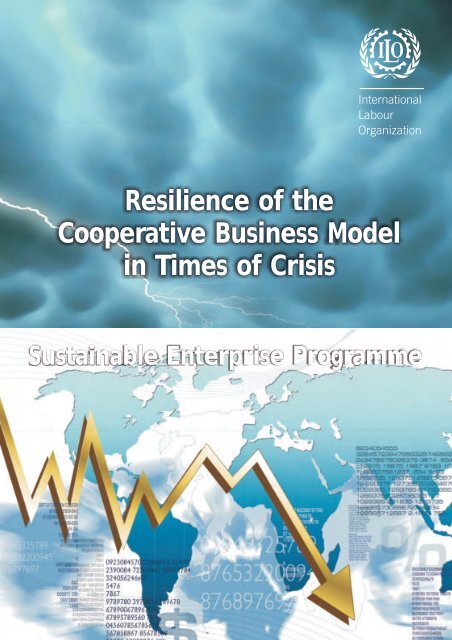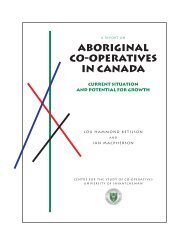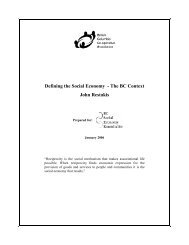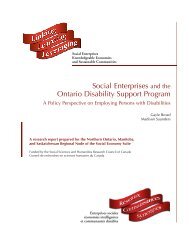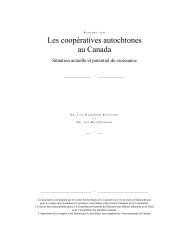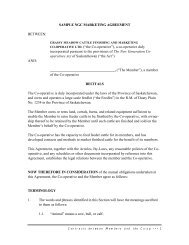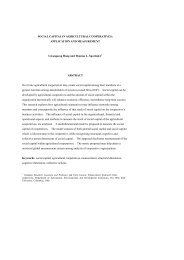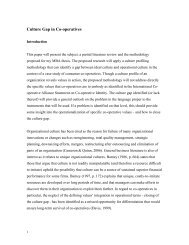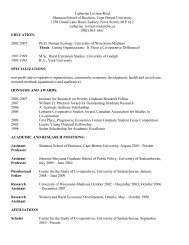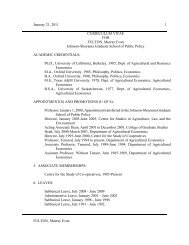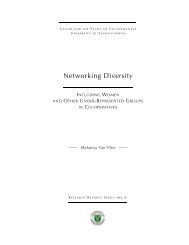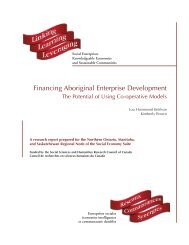mme Resilience of the Cooperative Business Model in Times of Crisis
mme Resilience of the Cooperative Business Model in Times of Crisis
mme Resilience of the Cooperative Business Model in Times of Crisis
Create successful ePaper yourself
Turn your PDF publications into a flip-book with our unique Google optimized e-Paper software.
International<br />
Labour<br />
Organization<br />
<strong>Resilience</strong> <strong>of</strong> <strong>the</strong><br />
<strong>Cooperative</strong> <strong>Bus<strong>in</strong>ess</strong> <strong>Model</strong><br />
<strong>in</strong> <strong>Times</strong> <strong>of</strong> <strong>Crisis</strong><br />
Susta<strong>in</strong>able Enterprise Progra<strong>mme</strong>
International Labour Organization<br />
Susta<strong>in</strong>able Enterprise Progra<strong>mme</strong><br />
<strong>Resilience</strong> <strong>of</strong><br />
<strong>the</strong> <strong>Cooperative</strong> <strong>Bus<strong>in</strong>ess</strong> <strong>Model</strong><br />
<strong>in</strong> <strong>Times</strong> <strong>of</strong> <strong>Crisis</strong><br />
Johnston Birchall 1 and Lou Hammond Ketilson 2<br />
1<br />
Johnston Birchall is Pr<strong>of</strong>essor <strong>of</strong> Social Policy at Stirl<strong>in</strong>g University, Scotland<br />
2<br />
Lou Hammond Ketilson is Director, Centre for <strong>Cooperative</strong> Studies, University <strong>of</strong> Saskatchewan,<br />
Canada. She would like to acknowledge <strong>the</strong> help <strong>of</strong> her research assistant, Dwayne<br />
Pattison
Copyright © International Labour Organization 2009<br />
First published 2009<br />
Publications <strong>of</strong> <strong>the</strong> International Labour Office enjoy copyright under Protocol 2 <strong>of</strong> <strong>the</strong> Universal Copyright<br />
Convention. Never<strong>the</strong>less, short excerpts from <strong>the</strong>m may be reproduced without authorization, on condition<br />
that <strong>the</strong> source is <strong>in</strong>dicated. For rights <strong>of</strong> reproduction or translation, application should be made to ILO Publications<br />
(Rights and Permissions), International Labour Office, CH-1211 Geneva 22, Switzerland, or by email:<br />
pubdroit@ilo.org. The International Labour Office welcomes such applications.<br />
Libraries, <strong>in</strong>stitutions and o<strong>the</strong>r users registered with reproduction rights organizations may make copies <strong>in</strong><br />
accordance with <strong>the</strong> licences issued to <strong>the</strong>m for this purpose. Visit http://www.ifrro.org to f<strong>in</strong>d <strong>the</strong> reproduction<br />
rights organization <strong>in</strong> your country.<br />
ISBN 978-92-2-122409-9 (pr<strong>in</strong>t);<br />
ISBN 978-92-2-122410-5 (web pdf)<br />
ISSN 1999-2939 (pr<strong>in</strong>t); ISSN 1999-2947 (web pdf)<br />
ILO Catalogu<strong>in</strong>g <strong>in</strong> Publication Data<br />
Birchall, Johnston; Ketilson, Lou Hammond<br />
<strong>Resilience</strong> <strong>of</strong> <strong>the</strong> cooperative bus<strong>in</strong>ess model <strong>in</strong> times <strong>of</strong> crisis / Johnston Birchall, Lou Hammond Ketilson ; International<br />
Labour Office, Susta<strong>in</strong>able Enterprise Progra<strong>mme</strong>. - Geneva: ILO, 2009<br />
1 v. (Responses to <strong>the</strong> global economic crisis<br />
ISBN: 9789221224099;9789221224105 (web pdf)<br />
International Labour Office<br />
cooperative / cooperative bank / credit cooperative / employment creation / economic recession<br />
03.05<br />
Johnston Birchall, Lou Hammond Ketilson<br />
<strong>Resilience</strong> <strong>of</strong> <strong>the</strong> cooperative bus<strong>in</strong>ess model <strong>in</strong> times <strong>of</strong> crisis;<br />
International Labour Office, Job Creation and Enterprise Development Department. - Geneva: ILO, 2009<br />
International Labour Office; Job Creation and Enterprise Development Dept<br />
The designations employed <strong>in</strong> ILO publications, which are <strong>in</strong> conformity with United Nations practice, and <strong>the</strong><br />
presentation <strong>of</strong> material <strong>the</strong>re<strong>in</strong> do not imply <strong>the</strong> expression <strong>of</strong> any op<strong>in</strong>ion whatsoever on <strong>the</strong> part <strong>of</strong> <strong>the</strong> International<br />
Labour Office concern<strong>in</strong>g <strong>the</strong> legal status <strong>of</strong> any country, area or territory or <strong>of</strong> its authorities, or<br />
concern<strong>in</strong>g <strong>the</strong> delimitation <strong>of</strong> its frontiers.<br />
The responsibility for op<strong>in</strong>ions expressed <strong>in</strong> signed articles, studies and o<strong>the</strong>r contributions rests solely with<br />
<strong>the</strong>ir authors, and publication does not constitute an endorsement by <strong>the</strong> International Labour Office <strong>of</strong> <strong>the</strong><br />
op<strong>in</strong>ions expressed <strong>in</strong> <strong>the</strong>m.<br />
Reference to names <strong>of</strong> firms and co<strong>mme</strong>rcial products and processes does not imply <strong>the</strong>ir endorsement by <strong>the</strong><br />
International Labour Office, and any failure to mention a particular firm, co<strong>mme</strong>rcial product or process is not<br />
a sign <strong>of</strong> disapproval.<br />
ILO publications and electronic products can be obta<strong>in</strong>ed through major booksellers or ILO local <strong>of</strong>fices <strong>in</strong><br />
many countries, or direct from ILO Publications, International Labour Office, CH-1211 Geneva 22, Switzerland.<br />
Catalogues or lists <strong>of</strong> new publications are availablefree<strong>of</strong>chargefrom<strong>the</strong>aboveaddress,orbyemail:<br />
pubvente@ilo.org<br />
Visit our website: http://www.ilo.org/publns<br />
Pr<strong>in</strong>ted <strong>in</strong> Italy
Table <strong>of</strong> contents<br />
Summary........................................................................2<br />
Introduction ....................................................................3<br />
1. <strong>Cooperative</strong>s thrive <strong>in</strong> times <strong>of</strong> crisis ..............................5<br />
1.1 Employee-owned co-operatives...............................7<br />
1.2. <strong>Cooperative</strong>s succeed only <strong>in</strong> crisis or also <strong>in</strong> crisis .......8<br />
2. Why are cooperatives good <strong>in</strong> a crisis...........................10<br />
2.1 The cooperative model <strong>of</strong> enterprise .......................10<br />
2.2 <strong>Cooperative</strong> performance <strong>in</strong> crisis ..........................13<br />
3. How are cooperative banks and credit unions far<strong>in</strong>g<br />
<strong>in</strong> <strong>the</strong> current crisis ................................................15<br />
3.1 Increase <strong>in</strong> assets and deposits ..............................17<br />
3.2 Significance <strong>of</strong> cooperative banks and sav<strong>in</strong>gs and<br />
credit cooperatives for f<strong>in</strong>ancial <strong>in</strong>clusion .................26<br />
3.3 The significance <strong>of</strong> cooperatives for employment<br />
creation and decent work ....................................29<br />
3.4 Policy responses ...............................................32<br />
3.5 How can <strong>the</strong> ILO assist its constituency to promote<br />
cooperatives to address <strong>the</strong> crisis and recovery..........36<br />
1
Summary<br />
The f<strong>in</strong>ancial and ensu<strong>in</strong>g economic crisis has had negative impacts on <strong>the</strong> majority<br />
<strong>of</strong> enterprises; however, cooperative enterprises around <strong>the</strong> world are<br />
show<strong>in</strong>g resilience to <strong>the</strong> crisis. F<strong>in</strong>ancial cooperatives rema<strong>in</strong> f<strong>in</strong>ancially<br />
sound; consumer cooperatives are report<strong>in</strong>g <strong>in</strong>creased turnover; worker cooperatives<br />
are see<strong>in</strong>g growth as people choose <strong>the</strong> cooperative form <strong>of</strong><br />
enterprise to respond to new economic realities.<br />
Why is this form <strong>of</strong> enterprise prov<strong>in</strong>g so resilient<br />
This report will provide historical evidence and current empirical evidence<br />
that proves that <strong>the</strong> cooperative model <strong>of</strong> enterprise survives crisis, but more<br />
importantly that it is a susta<strong>in</strong>able form <strong>of</strong> enterprise able to withstand crisis,<br />
ma<strong>in</strong>ta<strong>in</strong><strong>in</strong>g <strong>the</strong> livelihoods <strong>of</strong> <strong>the</strong> communities <strong>in</strong> which <strong>the</strong>y operate. It will<br />
fur<strong>the</strong>r suggest ways <strong>in</strong> which <strong>the</strong> ILO can streng<strong>the</strong>n its activity <strong>in</strong> <strong>the</strong> promotion<br />
<strong>of</strong> cooperatives as a means to address <strong>the</strong> current crisis and avert future<br />
crisis.<br />
2
Introduction<br />
The recent massive public bail-out <strong>of</strong> private, <strong>in</strong>vestor-owned banks has underl<strong>in</strong>ed<br />
<strong>the</strong> virtues <strong>of</strong> a customer-owned cooperative bank<strong>in</strong>g system that is<br />
more risk-averse and less driven by <strong>the</strong> need to make pr<strong>of</strong>its for <strong>in</strong>vestors and<br />
bonuses for managers. Sav<strong>in</strong>gs and credit cooperatives also known as credit<br />
unions or SACCOs, build<strong>in</strong>g societies and cooperative banks all over <strong>the</strong> world<br />
are report<strong>in</strong>g that <strong>the</strong>y are still f<strong>in</strong>ancially sound, and that customers are<br />
flock<strong>in</strong>g to bank with <strong>the</strong>m because <strong>the</strong>y are highly trusted. The po<strong>in</strong>t is an important<br />
one, because <strong>the</strong> cooperative bank<strong>in</strong>g sector is extraord<strong>in</strong>arily large;<br />
<strong>the</strong> World Council <strong>of</strong> Credit Unions has 49,000 credit unions <strong>in</strong> membership,<br />
with 177 million <strong>in</strong>dividual members <strong>in</strong><br />
96 countries. The International Raiffeisen Union estimates that 900,000 cooperatives<br />
with around 500 million members <strong>in</strong> over 100 countries are work<strong>in</strong>g<br />
accord<strong>in</strong>g to <strong>the</strong> cooperative bank<strong>in</strong>g pr<strong>in</strong>ciples worked out <strong>in</strong> Germany by<br />
Friedrich Raiffeisen. In Europe alone, <strong>the</strong>re are 4200 local cooperative banks,<br />
around 60,000 branches and a market share <strong>of</strong> 20%. The banks serve 45 million<br />
members and 159 million customers. 3 Some <strong>of</strong> <strong>the</strong> largest banks <strong>in</strong> <strong>the</strong> world<br />
are cooperatives: Rabobank, for <strong>in</strong>stance, has 50% <strong>of</strong> Dutch citizens <strong>in</strong> membership,<br />
is <strong>the</strong> largest agricultural bank <strong>in</strong> <strong>the</strong> world, and is rated <strong>the</strong> world’s<br />
third safest bank. 4 The essence <strong>of</strong> cooperative bank<strong>in</strong>g is quite simple. It is<br />
that members, who <strong>in</strong>clude both savers and borrowers, use <strong>the</strong> cooperative to<br />
recycle money from those who have it to those who need it, without anybody<br />
outside tak<strong>in</strong>g a pr<strong>of</strong>it and with <strong>in</strong>terest rates set so that <strong>the</strong> system works <strong>in</strong><br />
everyone’s <strong>in</strong>terest.<br />
3<br />
DeVries, B (2009) European <strong>Cooperative</strong> Banks <strong>in</strong> f<strong>in</strong>ancial and economic turmoil, Paper<br />
for <strong>the</strong> UN Expert Group Meet<strong>in</strong>g on <strong>Cooperative</strong>s, April, New York<br />
4<br />
By Global F<strong>in</strong>ance Magaz<strong>in</strong>e. It is also <strong>the</strong> only privately-owned bank with <strong>the</strong> highest possible<br />
credit rat<strong>in</strong>gs (see OCDC, 2007)<br />
3
ILO - Susta<strong>in</strong>able Enterprise Progra<strong>mme</strong><br />
This report beg<strong>in</strong>s by provid<strong>in</strong>g historical evidence that cooperatives are good<br />
<strong>in</strong> a crisis. This sets up a plausible generalisation that <strong>the</strong>y will cont<strong>in</strong>ue to be<br />
good <strong>in</strong> <strong>the</strong> current crisis.<br />
The report <strong>the</strong>n tests out this generalisation by provid<strong>in</strong>g <strong>the</strong>oretical arguments<br />
and empirical evidence for and aga<strong>in</strong>st it. It is <strong>in</strong> two parts.<br />
In <strong>the</strong> first part, it <strong>in</strong>vestigates <strong>the</strong> claim that cooperative banks and sav<strong>in</strong>gs<br />
and credit cooperatives are better able to withstand <strong>the</strong> bank<strong>in</strong>g crisis and<br />
economic recession than <strong>the</strong> <strong>in</strong>vestor-owned banks. It presents arguments for<br />
<strong>the</strong> advantages and disadvantages <strong>of</strong> ‘member-owned’ banks and tests <strong>the</strong>se<br />
aga<strong>in</strong>st <strong>the</strong> evidence. It f<strong>in</strong>ds that, so far, cooperatives are <strong>in</strong> an unusually<br />
strong position; <strong>the</strong>y have not been damaged much by <strong>the</strong> bank<strong>in</strong>g crisis, and<br />
are grow<strong>in</strong>g strongly as<br />
customers switch<br />
<strong>the</strong>ir bus<strong>in</strong>ess away<br />
from <strong>the</strong> discredited<br />
<strong>in</strong>vestor-owned banks<br />
and o<strong>the</strong>r enterprises<br />
to what <strong>the</strong>y see as a<br />
more risk-averse and<br />
trustworthy sector.<br />
In <strong>the</strong> second part,<br />
<strong>the</strong> report <strong>the</strong>n considers<br />
two important<br />
policy aims - f<strong>in</strong>ancial<br />
<strong>in</strong>clusion and employment<br />
creation - present<strong>in</strong>g<br />
evidence for<br />
<strong>the</strong> importance <strong>of</strong> cooperatives <strong>in</strong> achiev<strong>in</strong>g <strong>the</strong>m dur<strong>in</strong>g a time <strong>of</strong> economic<br />
recession.<br />
F<strong>in</strong>ally, <strong>the</strong> report considers <strong>the</strong> policy implications <strong>of</strong> <strong>the</strong>se f<strong>in</strong>d<strong>in</strong>gs for governments<br />
and bank<strong>in</strong>g regulators and what <strong>the</strong> ILO can do with regard <strong>the</strong> promotion<br />
<strong>of</strong> cooperatives.<br />
4
1. <strong>Cooperative</strong>s thrive <strong>in</strong> times<br />
<strong>of</strong> crisis<br />
Dur<strong>in</strong>g an agricultural depression <strong>in</strong> 1860s Germany, a social reformer,<br />
Friedrich Raiffeisen, provided emergency food aid to hungry farmers and <strong>the</strong>ir<br />
families, but <strong>the</strong>n realised that what <strong>the</strong>y really needed was credit to help<br />
<strong>the</strong>m to modernise <strong>the</strong>ir methods and ga<strong>in</strong> access to markets for <strong>the</strong>ir produce.<br />
He designed a new type <strong>of</strong> sav<strong>in</strong>gs and credit cooperative which was enthusiastically<br />
taken up by <strong>the</strong> farmers; <strong>the</strong> idea <strong>of</strong> <strong>the</strong> rural cooperative bank spread<br />
throughout ma<strong>in</strong>land Europe, and led to promotion <strong>of</strong> supply and market<strong>in</strong>g cooperatives.<br />
Toge<strong>the</strong>r, <strong>the</strong>y helped develop <strong>the</strong> modern farm economy. At <strong>the</strong><br />
same time, ano<strong>the</strong>r social reformer, Schultze-Delitsch, <strong>in</strong>vented a similar type<br />
<strong>of</strong> cooperative bank for townspeople, provid<strong>in</strong>g credits to enable artisans and<br />
small bus<strong>in</strong>ess people to survive <strong>in</strong> <strong>the</strong> rapid economic changes and frequent<br />
depressions that accompanied <strong>the</strong> <strong>in</strong>dustrial revolution. Similarly, <strong>in</strong> <strong>the</strong> United<br />
States, dur<strong>in</strong>g <strong>the</strong> Great Depression <strong>in</strong> <strong>the</strong> 1930s, a cooperative bank was set up<br />
with government support under <strong>the</strong> New Deal, to provide vital farm credits. At<br />
this time, <strong>the</strong> Federal Credit Union Act was passed ‘to ensure credit unions<br />
made credit available to “people <strong>of</strong> small means”’, and it is <strong>in</strong>terest<strong>in</strong>g to note<br />
that The Act was ‘meant to stabilize an imbalanced global f<strong>in</strong>ancial system’. 5<br />
Also <strong>in</strong> <strong>the</strong> United States dur<strong>in</strong>g <strong>the</strong> Great Depression, agricultural cooperatives<br />
began to be formed <strong>in</strong> large numbers. <strong>Cooperative</strong> farm supply purchas<strong>in</strong>g<br />
grew from US$76 million <strong>in</strong> 1924 to US$250 million <strong>in</strong> 1934, and spread to all<br />
parts <strong>of</strong> <strong>the</strong> USA. It was around this time that Land O’Lakes emerged as a significant<br />
regional dairy cooperative. Also <strong>the</strong>re was a rapid growth <strong>in</strong> petroleum cooperatives<br />
supply<strong>in</strong>g farmers; by 1935 <strong>the</strong>re were around 2000 <strong>of</strong> <strong>the</strong>m<br />
5<br />
Meyer, M. (2008). Does Capitalism Need Cooperation <strong>Cooperative</strong> <strong>Bus<strong>in</strong>ess</strong> Journal<br />
November/December p4<br />
5
ILO - Susta<strong>in</strong>able Enterprise Progra<strong>mme</strong><br />
supply<strong>in</strong>g products<br />
worth US$40 million.<br />
There was government<br />
support <strong>in</strong> <strong>the</strong> form <strong>of</strong><br />
credit, but farmers<br />
were encouraged to<br />
take control <strong>of</strong> <strong>the</strong>ir<br />
own cooperative banks.<br />
By 1935 <strong>the</strong>re were<br />
10,500 farmer cooperatives<br />
with a membership<br />
<strong>of</strong> 3.66 million<br />
farmers. 6<br />
Similarly, <strong>in</strong> Sweden after<br />
<strong>the</strong> price collapse <strong>of</strong><br />
1930, <strong>in</strong>stead <strong>of</strong> cooperatives giv<strong>in</strong>g way to state market<strong>in</strong>g boards, cooperative<br />
federations took control <strong>in</strong> farm credit, dairy, forestry, eggs, meat and<br />
fruit, presided over by a strong National Union <strong>of</strong> Swedish Farmers.<br />
In a more recent depression <strong>in</strong> farm prices <strong>in</strong> <strong>the</strong> US and Canada, a new type <strong>of</strong><br />
cooperative was devised that aligns farmer share-ownership to delivery rights,<br />
thus enabl<strong>in</strong>g farmers to go <strong>in</strong>to food process<strong>in</strong>g. There are around 200 <strong>of</strong> <strong>the</strong>se<br />
‘new generation’ cooperatives, and <strong>the</strong>y have raised <strong>the</strong> <strong>in</strong>comes <strong>of</strong> farmers<br />
dramatically and revitalised <strong>the</strong> local economies <strong>of</strong> North Dakota, M<strong>in</strong>nesota<br />
and neighbour<strong>in</strong>g states. 7 More recently, <strong>the</strong> BSE (or mad cow) crisis <strong>in</strong> Canada<br />
was <strong>the</strong> major impetus beh<strong>in</strong>d cattle producers <strong>in</strong> Alberta, Canada form<strong>in</strong>g<br />
several producer cooperatives <strong>in</strong> <strong>the</strong> prov<strong>in</strong>ce. 8<br />
Dur<strong>in</strong>g <strong>the</strong> 1840s <strong>in</strong> Brita<strong>in</strong>, at a time <strong>of</strong> desperate economic hardship, retail<br />
consumer cooperatives began to be formed among textile workers as <strong>the</strong> only<br />
alternative to emigration or starvation. They wea<strong>the</strong>red many crises, <strong>in</strong>clud<strong>in</strong>g<br />
two world wars and <strong>the</strong> great depression, com<strong>in</strong>g out stronger every time<br />
until by <strong>the</strong> 1950s <strong>the</strong>y had 12% <strong>of</strong> <strong>the</strong> retail trade and had given rise to similar<br />
6<br />
USDA Rural Development (1935) <strong>Cooperative</strong>s help farmers survive <strong>the</strong> great depression,<br />
accessed April 2009 at www.rurdev.usda.gov<br />
7<br />
Merrett, C and Walzer, N (eds, 2001) A <strong>Cooperative</strong> Approach to Local Economic Development,<br />
Quorum Books<br />
8<br />
Canadian <strong>Cooperative</strong> Association (2005, Dec) Coops <strong>in</strong> Alberta Fact Sheet. Retrieved<br />
from: http://www.coopscanada.coop/pdf/Sector/FactSheet/Alberta%20coops.pdf<br />
6
<strong>Resilience</strong> <strong>of</strong> <strong>the</strong> cooperative bus<strong>in</strong>ess model <strong>in</strong> times <strong>of</strong> crises<br />
cooperative sectors throughout Europe. 9 Their ability to withstand shocks and<br />
to provide a distribution network guarantee<strong>in</strong>g food supplies led to <strong>the</strong>ir use <strong>in</strong><br />
reconstruction <strong>in</strong> Germany and Japan after <strong>the</strong> Second World War. More recently,<br />
when <strong>the</strong> Soviet Union collapsed consumer cooperatives around Moscow<br />
not only survived <strong>the</strong> economic crisis but restructured and began to grow aga<strong>in</strong>. 10<br />
O<strong>the</strong>r forms <strong>of</strong> consumer cooperative have proved <strong>the</strong>ir worth.<br />
Dur<strong>in</strong>g <strong>the</strong> 1930s depression electricity and telecommunication cooperatives<br />
helped transform <strong>the</strong> rural economy <strong>of</strong> <strong>the</strong> US. Dur<strong>in</strong>g <strong>the</strong> 1960s <strong>the</strong> city <strong>of</strong> New<br />
York began foreclos<strong>in</strong>g on thousands <strong>of</strong> landlord-owned properties for non-payment<br />
<strong>of</strong> taxes, and landlords responded by abandon<strong>in</strong>g <strong>the</strong>ir tenement blocks.<br />
Out <strong>of</strong> this crisis was born a cooperative hous<strong>in</strong>g movement that successfully<br />
housed 27,000 families. Today, cooperative ownership is <strong>the</strong> most common form<br />
<strong>of</strong> apartment ownership <strong>in</strong> New York City. 11<br />
1.1 Employee-owned co-operatives<br />
Dur<strong>in</strong>g <strong>the</strong> 1970s and early 1980s <strong>in</strong> Western Europe, a fundamental restructur<strong>in</strong>g<br />
<strong>of</strong> <strong>in</strong>dustry took place that led to mass unemployment. The response <strong>of</strong><br />
many employees was a wave <strong>of</strong> takeovers through employee-owned cooperatives<br />
that managed to m<strong>in</strong>imize <strong>the</strong> loss <strong>of</strong> jobs from <strong>in</strong>dustrial change. Similarly<br />
<strong>in</strong> Argent<strong>in</strong>a <strong>in</strong> 2001, after a serious f<strong>in</strong>ancial meltdown had led to<br />
thousands<strong>of</strong>bankruptcies,workerstookoverupwards<strong>of</strong>200firmsand,with<br />
government support, ran <strong>the</strong>m <strong>the</strong>mselves (known as ‘empresas<br />
recuperadas’). 12 The severe recession experienced <strong>in</strong> F<strong>in</strong>land <strong>in</strong> <strong>the</strong> early<br />
1990s after <strong>the</strong> Soviet Union collapsed led <strong>in</strong> part to unemployment reach<strong>in</strong>g<br />
more than 20%. The response was a ‘new wave’ <strong>of</strong> worker cooperatives promoted<br />
and supported by <strong>the</strong> M<strong>in</strong>istry <strong>of</strong> Labour and <strong>the</strong> F<strong>in</strong>nish <strong>Cooperative</strong><br />
Movement which led to over 1200 labour cooperatives designed to get unemployed<br />
people back <strong>in</strong>to work. 13 7<br />
9<br />
Birchall, J (1994) Coop: <strong>the</strong> People’s <strong>Bus<strong>in</strong>ess</strong>, Manchester University Press<br />
10<br />
Birchall (2003) Rediscover<strong>in</strong>g <strong>the</strong> <strong>Cooperative</strong> Advantage, Geneva: ILO p55-57<br />
11<br />
Coldwell Banker. Understand<strong>in</strong>g <strong>Cooperative</strong>s and Condom<strong>in</strong>iums<br />
12<br />
Howarth, M (2007) Worker cooperatives and <strong>the</strong> phenomenon <strong>of</strong> empresas recuperadas <strong>in</strong><br />
Argent<strong>in</strong>a, Manchester: <strong>Cooperative</strong> College<br />
13<br />
Birchall, J (2003) op cit p48-51
ILO - Susta<strong>in</strong>able Enterprise Progra<strong>mme</strong><br />
1.2 <strong>Cooperative</strong>s succeed only <strong>in</strong> crisis<br />
or also <strong>in</strong> crisis<br />
Does this mean cooperatives only succeed at a time <strong>of</strong> economic crisis Are<br />
<strong>the</strong>y a bus<strong>in</strong>ess type that people turn to when it is needed, only to return to<br />
<strong>the</strong> dom<strong>in</strong>ant <strong>in</strong>vestor-owned model when <strong>the</strong> crisis is over<br />
There is no evidence for this. In fact, it is <strong>the</strong> strength built up by cooperatives<br />
dur<strong>in</strong>g <strong>the</strong> good times that helps tide <strong>the</strong>m over a recession. The International<br />
Co-operative Alliance (ICA) calculated <strong>in</strong> 2004 – four years before <strong>the</strong> bank<strong>in</strong>g crisis–that<strong>the</strong>top300cooperatives<strong>in</strong><strong>the</strong>worldhadaround<strong>the</strong>sameoutputas<strong>the</strong><br />
GDP <strong>of</strong> Canada. 14 A study <strong>of</strong> cooperatives <strong>in</strong> 11 countries <strong>in</strong> Africa estimates that<br />
around seven percent <strong>of</strong><br />
Africans are cooperative<br />
members and that<br />
even <strong>in</strong> countries<br />
where cooperatives<br />
unions have collapsed,<br />
such as Uganda and<br />
Rwanda, <strong>the</strong> numbers<br />
have cont<strong>in</strong>ued to<br />
grow; <strong>the</strong>re were only<br />
554 cooperatives registered<br />
<strong>in</strong> Uganda <strong>in</strong><br />
1995, but nearly 7,500<br />
today. Sav<strong>in</strong>gs and<br />
credit cooperatives are<br />
grow<strong>in</strong>g everywhere. 15<br />
It is true that <strong>in</strong> some countries such as <strong>the</strong> US and United K<strong>in</strong>gdom<br />
demutualisation had, over <strong>the</strong> previous decade, been a strong destroyer <strong>of</strong> cooperatives.<br />
The arguments were that cooperatives and mutuals were an outmoded<br />
bus<strong>in</strong>ess type that could not provide <strong>in</strong>centives to attract <strong>the</strong> best<br />
managers, and could not raise enough capital to compete <strong>in</strong> global markets.<br />
These arguments have come back to haunt <strong>the</strong> demutualised companies,<br />
many <strong>of</strong> which (for example Bradford and B<strong>in</strong>gley and Nor<strong>the</strong>rn Rock <strong>in</strong> <strong>the</strong><br />
14<br />
See www.ica.coop for <strong>the</strong> Global 300 project<br />
15<br />
Develtere, P, Pollet, I and Wanyama, F (2008) Cooperat<strong>in</strong>g out <strong>of</strong> Poverty: <strong>the</strong> renaissance<br />
<strong>of</strong> <strong>the</strong> African cooperative movement, Geneva: ILO<br />
8
<strong>Resilience</strong> <strong>of</strong> <strong>the</strong> cooperative bus<strong>in</strong>ess model <strong>in</strong> times <strong>of</strong> crises<br />
©ILO/Lord<br />
UK) have become<br />
bankrupt, <strong>the</strong>ir management<br />
discredited,<br />
and <strong>the</strong>ir shares<br />
worthless. There is<br />
now a countertrend.<br />
Just as <strong>in</strong> <strong>the</strong> 1930s<br />
many life <strong>in</strong>surance<br />
companies mutualised<br />
<strong>in</strong> order to ga<strong>in</strong><br />
<strong>the</strong> trust <strong>of</strong> <strong>the</strong>ir customers,<br />
<strong>in</strong> <strong>the</strong> current<br />
crisis <strong>the</strong>re are calls for<br />
remutualisation <strong>of</strong> <strong>the</strong><br />
UK build<strong>in</strong>g societies<br />
that became banks, and for <strong>the</strong> eventual mutualisation <strong>of</strong> private banks such<br />
as Lloyds Bank<strong>in</strong>g Group and RBS that are now ma<strong>in</strong>ly owned by <strong>the</strong> government.<br />
Of course, as with any o<strong>the</strong>r type <strong>of</strong> bus<strong>in</strong>ess, if a cooperative is be<strong>in</strong>g badly<br />
managed or has serious weaknesses <strong>in</strong> its bus<strong>in</strong>ess strategy, a recession will<br />
f<strong>in</strong>d this out and it may fail.<br />
The cooperative model provides comparative advantages, but no magic formula<br />
for success. However, it is <strong>in</strong>terest<strong>in</strong>g to see just how strongly cooperative<br />
banks, sav<strong>in</strong>gs and credit cooperatives and credit unions are perform<strong>in</strong>g<br />
dur<strong>in</strong>g <strong>the</strong> current bank<strong>in</strong>g crisis, and how little help <strong>the</strong>y have needed from<br />
governments, <strong>in</strong> contrast to <strong>the</strong>ir <strong>in</strong>vestor-owned competitors who have had to<br />
be bailed out with stagger<strong>in</strong>gly large amounts <strong>of</strong> public fund<strong>in</strong>g. Where cooperatives<br />
and mutuals do get <strong>in</strong>to trouble, <strong>the</strong>y can rely on federal bodies that provide<br />
guarantee funds or ensure <strong>the</strong>y merge with o<strong>the</strong>rs so <strong>the</strong> assets are not lost<br />
and <strong>the</strong>ir members are protected.<br />
What is remarkable is that worldwide hardly any cooperative banks or credit<br />
unions have had to ask for government help. Why should <strong>the</strong> cooperative<br />
model have proved so strong<br />
9
2. Why are cooperatives good<br />
<strong>in</strong> a crisis<br />
2.1 The cooperative model <strong>of</strong> enterprise<br />
<strong>Cooperative</strong>s are<br />
member-owned bus<strong>in</strong>esses.<br />
The simplest<br />
way to understand<br />
<strong>the</strong>m is that <strong>the</strong>y aggregate<br />
<strong>the</strong> market<br />
power <strong>of</strong> people who<br />
on <strong>the</strong>ir own could<br />
achieve little or noth<strong>in</strong>g,<br />
and <strong>in</strong> so do<strong>in</strong>g<br />
<strong>the</strong>y provide ways out<br />
<strong>of</strong> poverty and<br />
powerlessness.<br />
The <strong>in</strong>ternationally<br />
recognized def<strong>in</strong>ition <strong>of</strong><br />
cooperatives <strong>in</strong>cluded <strong>in</strong> both United Nations Guidel<strong>in</strong>es aimed at creat<strong>in</strong>g a<br />
supportive environment for <strong>the</strong> development <strong>of</strong> cooperatives (2001) and ILO<br />
R.193 (2002) and as established by <strong>the</strong> representative body for cooperatives,<br />
<strong>the</strong> International Co-operative Alliance (ICA), is:<br />
An autonomous association <strong>of</strong> persons united voluntarily to meet <strong>the</strong>ir<br />
common economic, social and cultural needs and aspirations, through<br />
a jo<strong>in</strong>tly owned and democratically controlled enterprise. 16<br />
©ILO/M.Crozet<br />
16<br />
See International <strong>Cooperative</strong> Alliance website, www.ica.coop<br />
10
<strong>Resilience</strong> <strong>of</strong> <strong>the</strong> cooperative bus<strong>in</strong>ess model <strong>in</strong> times <strong>of</strong> crises<br />
©ILO/M.Crozet<br />
<strong>Cooperative</strong>s are also guided by seven cooperative pr<strong>in</strong>ciples: voluntary and<br />
open membership; democratic member control; member economic participation;<br />
autonomy and <strong>in</strong>dependence; education, tra<strong>in</strong><strong>in</strong>g and <strong>in</strong>formation; cooperation<br />
among cooperatives; and concern for community.<br />
The first four <strong>of</strong> <strong>the</strong>se are core pr<strong>in</strong>ciples without which a cooperative would<br />
lose its identity; <strong>the</strong>y guarantee <strong>the</strong> conditions under which members own,<br />
control and benefit from <strong>the</strong> bus<strong>in</strong>ess. The education pr<strong>in</strong>ciple is a commitment<br />
to make membership effective and so is a precondition for democratic<br />
control, while cooperation among cooperatives is really a bus<strong>in</strong>ess strategy<br />
without which cooperatives rema<strong>in</strong> economically vulnerable. The last pr<strong>in</strong>ciple,<br />
concern for community, recognises that, unlike <strong>in</strong>vestors, cooperative<br />
members tend also to be members <strong>of</strong> a particular community. Often, one <strong>of</strong><br />
<strong>the</strong> bus<strong>in</strong>ess aims for <strong>the</strong> cooperative is that it will meet <strong>the</strong> needs <strong>of</strong> this<br />
wider community. This does not mean that cooperatives are ‘social’ ra<strong>the</strong>r<br />
than economic, and can just be used as a tool <strong>of</strong> development. It is important<br />
to dist<strong>in</strong>guish between <strong>the</strong> primary aims <strong>of</strong> <strong>the</strong> cooperative, which are to<br />
meet <strong>the</strong> members’ economic needs, by-products such as improved nutrition<br />
and <strong>in</strong>creased capabilities, and aggregate effects <strong>in</strong> <strong>the</strong> wider society such as<br />
lower mortality rates or higher employment levels. Paradoxically, <strong>in</strong> order to<br />
achieve <strong>the</strong>se wider goals governments need to respect <strong>the</strong> autonomy <strong>of</strong><br />
cooperatives.<br />
The diversity <strong>of</strong> types <strong>of</strong><br />
cooperative can be<br />
confus<strong>in</strong>g, and so here<br />
is a simple way <strong>of</strong> classify<strong>in</strong>g<br />
<strong>the</strong>m. Apart<br />
from <strong>the</strong> <strong>in</strong>vestors <strong>of</strong><br />
capital, <strong>the</strong>re are<br />
three ma<strong>in</strong> stakeholders<br />
<strong>in</strong> a bus<strong>in</strong>ess:<br />
its consumers, <strong>the</strong> producers<br />
who supply <strong>in</strong>puts<br />
to or take <strong>the</strong><br />
outputs from <strong>the</strong> bus<strong>in</strong>ess,<br />
and its employees.<br />
In a cooperative,<br />
usually one <strong>of</strong> <strong>the</strong>se<br />
11
ILO - Susta<strong>in</strong>able Enterprise Progra<strong>mme</strong><br />
stakeholders is put at<br />
<strong>the</strong> centre <strong>of</strong> <strong>the</strong><br />
bus<strong>in</strong>ess. This gives us<br />
three classes: consumer<br />
cooperatives,<br />
producer cooperatives<br />
and worker cooperatives.<br />
There is<br />
one <strong>in</strong>terest<strong>in</strong>g complication.<br />
F<strong>in</strong>ancial<br />
cooperatives – cooperative<br />
banks, <strong>in</strong>surance<br />
societies and<br />
credit unions – <strong>of</strong>ten<br />
have <strong>in</strong> membership<br />
people who are consumers <strong>of</strong> <strong>the</strong>ir products and – <strong>in</strong> <strong>the</strong>ir own right – producers.<br />
So farmers and small bus<strong>in</strong>esses can be members alongside private <strong>in</strong>dividuals.<br />
As long as <strong>the</strong> <strong>in</strong>terests <strong>of</strong> each group do not conflict, <strong>the</strong> cooperative works<br />
well.<br />
There are two k<strong>in</strong>ds <strong>of</strong> comparative advantage to cooperatives: general ones<br />
derived from <strong>the</strong> nature <strong>of</strong> cooperatives as member-owned bus<strong>in</strong>esses, and<br />
particular ones derived from specific types <strong>of</strong> cooperative.<br />
The general advantages are derived from membership. <strong>Cooperative</strong>s are<br />
uniquely member- owned, member-controlled and exist to provide benefits to<br />
members as opposed to pr<strong>of</strong>it and this has an impact on bus<strong>in</strong>ess decisions.<br />
When <strong>the</strong> purposes <strong>of</strong> <strong>the</strong> bus<strong>in</strong>ess are aligned with those <strong>of</strong> members who are<br />
both <strong>in</strong>vestors and consumers <strong>of</strong> <strong>the</strong> cooperative, <strong>the</strong> results are loyalty, commitment,<br />
shared knowledge, member participation, underp<strong>in</strong>ned by strong<br />
economic <strong>in</strong>centives. 17 These are <strong>the</strong> k<strong>in</strong>ds <strong>of</strong> values any bus<strong>in</strong>ess organisation<br />
would want but that <strong>in</strong>vestor-owned bus<strong>in</strong>ess can only achieve by mimick<strong>in</strong>g<br />
<strong>the</strong> idea <strong>of</strong> membership. The general disadvantages are <strong>the</strong> obverse <strong>of</strong><br />
<strong>the</strong> advantages; when <strong>the</strong> purposes <strong>of</strong> <strong>the</strong> bus<strong>in</strong>ess are not aligned with those<br />
<strong>of</strong> <strong>the</strong> members, apathy or cynicism result, members lose <strong>in</strong>terest and cease<br />
to participate. This leads to management pursu<strong>in</strong>g <strong>the</strong>ir own <strong>in</strong>terests, and to<br />
complacency and a re<strong>in</strong>forcement <strong>of</strong> oligarchic tendencies among <strong>the</strong> board.<br />
17<br />
Shah, T (1996) Catalys<strong>in</strong>g Cooperation: design <strong>of</strong> self-govern<strong>in</strong>g organisations, New Delhi:<br />
Sage<br />
12
<strong>Resilience</strong> <strong>of</strong> <strong>the</strong> cooperative bus<strong>in</strong>ess model <strong>in</strong> times <strong>of</strong> crises<br />
The particular advantages<br />
<strong>of</strong> consumer cooperatives<br />
are that<br />
<strong>the</strong>y provide people<br />
with consumption<br />
goods at <strong>the</strong> lowest<br />
possible price and with<br />
a guarantee <strong>of</strong> good<br />
value, and so make<br />
<strong>the</strong>ir <strong>in</strong>come go fur<strong>the</strong>r.<br />
Producer cooperatives<br />
enable selfemployed<br />
people and<br />
family bus<strong>in</strong>esses to<br />
ga<strong>in</strong> <strong>the</strong> strength <strong>in</strong><br />
numbers <strong>the</strong>y need to survive <strong>in</strong> <strong>the</strong> market. Worker cooperatives provide people<br />
with an <strong>in</strong>come, but also are a way <strong>of</strong> ga<strong>in</strong><strong>in</strong>g control over <strong>the</strong> conditions under<br />
which <strong>the</strong>y labour, provid<strong>in</strong>g ‘decent work’ . However, <strong>the</strong>se advantages cannot<br />
always be realised; we have to take <strong>in</strong>to account <strong>the</strong> extent to which cooperatives<br />
have <strong>the</strong> capacity to realise <strong>the</strong>m and <strong>the</strong> <strong>in</strong>tensity <strong>of</strong> competition <strong>the</strong>y are fac<strong>in</strong>g.<br />
From an evolutionary po<strong>in</strong>t <strong>of</strong> view, <strong>the</strong>y are <strong>in</strong> competition with o<strong>the</strong>r types <strong>of</strong> organisation<br />
do<strong>in</strong>g <strong>the</strong> same job, and <strong>the</strong>se o<strong>the</strong>r types also have <strong>the</strong>ir advantages<br />
and disadvantages.<br />
2.2 <strong>Cooperative</strong> performance <strong>in</strong> crisis<br />
There are two crises; <strong>the</strong> bank<strong>in</strong>g crisis and <strong>the</strong> result<strong>in</strong>g recession.<br />
F<strong>in</strong>ancial cooperatives can help lessen <strong>the</strong> impact <strong>of</strong> <strong>the</strong> bank<strong>in</strong>g crisis. They do<br />
this by cont<strong>in</strong>u<strong>in</strong>g to trade without <strong>the</strong> need for government bail-outs, and<br />
demonstrat<strong>in</strong>g that a more risk-averse sector exists that is focused on <strong>the</strong> needs<br />
<strong>of</strong> customer-members. They show that <strong>the</strong>re is an alternative to <strong>the</strong> current<br />
policy <strong>of</strong> greater public regulation <strong>of</strong> private banks, while <strong>in</strong> many countries<br />
also provid<strong>in</strong>g bank<strong>in</strong>g and <strong>in</strong>surance to low <strong>in</strong>come people who would o<strong>the</strong>rwise<br />
be unbanked.<br />
<strong>Cooperative</strong>s can lessen <strong>the</strong> impact <strong>of</strong> <strong>the</strong> recession by <strong>the</strong> mere fact that <strong>the</strong>y<br />
survive and cont<strong>in</strong>ue to carry out bus<strong>in</strong>ess. There is evidence that cooperatives<br />
<strong>in</strong> all sectors survive better than <strong>the</strong>ir competitors; <strong>the</strong> rate <strong>of</strong> survival <strong>of</strong> new<br />
13
ILO - Susta<strong>in</strong>able Enterprise Progra<strong>mme</strong><br />
start ups is better, and <strong>the</strong> longevity <strong>of</strong> cooperatives is impressive. They can use<br />
member capital ra<strong>the</strong>r than bank borrow<strong>in</strong>g to expand <strong>the</strong> bus<strong>in</strong>ess, and <strong>the</strong>y<br />
provide services to more risk-averse consumers. More specifically, worker cooperatives<br />
can concentrate on employment creation through labour cooperatives,<br />
employee buyouts and rescues, consumer cooperatives on lower<strong>in</strong>g <strong>the</strong><br />
cost <strong>of</strong> food and o<strong>the</strong>r essentials, and producer cooperatives on mak<strong>in</strong>g members’<br />
bus<strong>in</strong>esses more productive. 18<br />
It is generally agreed that <strong>the</strong> recession will hit develop<strong>in</strong>g countries hard. It<br />
can be countered by cont<strong>in</strong>ued streng<strong>the</strong>n<strong>in</strong>g <strong>of</strong> <strong>the</strong> sav<strong>in</strong>gs and credit/credit<br />
union/SACCO sector and development <strong>of</strong> farmer cooperatives and new cooperative<br />
unions or federations to develop <strong>the</strong>ir bus<strong>in</strong>ess. Also important are <strong>the</strong><br />
streng<strong>the</strong>n<strong>in</strong>g <strong>of</strong> l<strong>in</strong>ks between cooperatives North and South, through technical<br />
assistance, product development and fair trade. There are also great opportunities<br />
to cont<strong>in</strong>ue <strong>the</strong> development <strong>of</strong> mutually owned utilities such as<br />
electricity and water.<br />
©ILO/Virot<br />
18<br />
See Birchall, J (2009) Discussion paper at <strong>the</strong> Expert group meet<strong>in</strong>g on ‘<strong>Cooperative</strong>s <strong>in</strong> a<br />
World <strong>in</strong> <strong>Crisis</strong>’, 28-30 April 2009, New York<br />
14
3. How are cooperative banks and<br />
credit unions far<strong>in</strong>g <strong>in</strong> <strong>the</strong> current crisis<br />
When former US Federal Reserve Chairman Alan Greenspan went before Congress<br />
<strong>in</strong> October 2008, he told American lawmakers that <strong>the</strong> economic meltdown<br />
had revealed a “flaw <strong>in</strong> <strong>the</strong> model” that he had not expected – that<br />
banks operat<strong>in</strong>g <strong>in</strong> self-<strong>in</strong>terest would not self-regulate to protect <strong>the</strong>ir shareholders<br />
and <strong>in</strong>stitutions. 19<br />
The type <strong>of</strong> ownership and methods <strong>of</strong> capitalization are two <strong>of</strong> <strong>the</strong> key factors<br />
that have created <strong>the</strong> disparity <strong>in</strong> <strong>the</strong> f<strong>in</strong>ancial positions <strong>of</strong> credit unions<br />
and banks, to <strong>the</strong> advantage <strong>of</strong> sav<strong>in</strong>gs and credit cooperatives or credit unions.Because<strong>the</strong>searememberowned<strong>the</strong>ytendtobemoreriskaversecompared<br />
to o<strong>the</strong>r f<strong>in</strong>ancial <strong>in</strong>stitutions. 20 sav<strong>in</strong>gs and credit cooperatives are not<br />
driven by pr<strong>of</strong>its or shareholder <strong>in</strong>terests so <strong>the</strong>y do not feel compelled to<br />
force people <strong>in</strong>to <strong>in</strong>appropriate loans. 21 Thus, sav<strong>in</strong>gs and credit cooperativeshavestayedawayfrom<strong>of</strong>fer<strong>in</strong>g<strong>the</strong>riskiersub-primeloans.Theyhavea<br />
different k<strong>in</strong>d <strong>of</strong> governance structure, <strong>in</strong> which local credit unions and cooperative<br />
banks scrut<strong>in</strong>ise <strong>the</strong> decisions <strong>of</strong> <strong>the</strong> central <strong>in</strong>stitutions. In this way,<br />
<strong>the</strong>y are more aware <strong>of</strong> <strong>the</strong> fact that <strong>the</strong> loan <strong>the</strong>y <strong>of</strong>fer to <strong>the</strong>ir members is<br />
ano<strong>the</strong>r member’s money. The direct l<strong>in</strong>k <strong>of</strong> sav<strong>in</strong>gs and loans, which may not<br />
be as apparent <strong>in</strong> some banks, acts as a moral constra<strong>in</strong>t.<br />
19<br />
McCabe, D (2009) Economics Shrugged, <strong>in</strong> University Affairs, April<br />
20<br />
Coombes, A. (2008, April 27). Given Turmoil at Banks, Time May Be Right to Try a Credit<br />
Union. MarketWatch. Retrieved from: http://www.foxbus<strong>in</strong>ess.com/story/markets/<strong>in</strong>dustries/f<strong>in</strong>ance/given-turmoil-banks-time-right-try-credit-union/<br />
21<br />
McDougall, P. (2008, September 12) Credit Unions Take On Big Banks. TheStreet.com. Retrieved<br />
from: http://www.<strong>the</strong>street.com/story/10437101/1/credit-unions-take-on-bigbanks.html<br />
15
ILO - Susta<strong>in</strong>able Enterprise Progra<strong>mme</strong><br />
<strong>Cooperative</strong> banks and sav<strong>in</strong>gs and credit<br />
cooperatives are not reliant upon <strong>the</strong> capital<br />
markets for fund<strong>in</strong>g, but are funded<br />
through member deposits. 22 They are<br />
strong <strong>in</strong> retail bank<strong>in</strong>g, which is characterised<br />
by stable returns and comparatively<br />
good access to sav<strong>in</strong>gs and deposits.<br />
They are not able to go to <strong>the</strong> markets to<br />
obta<strong>in</strong> easy money from <strong>in</strong>vestors, and so<br />
<strong>the</strong>y tend to reta<strong>in</strong> <strong>the</strong>ir pr<strong>of</strong>its and take<br />
fewer risks. 23 This is one reason why <strong>the</strong>y<br />
also have higher capital reserve criteria.<br />
Ano<strong>the</strong>r example <strong>of</strong> <strong>the</strong>ir aversion to risk is<br />
<strong>the</strong>ir additional deposit guarantee<br />
schemes that serve as extra security.<br />
Ferri (circa 2006) <strong>of</strong>fers three reasons why<br />
cooperatives may be beneficial dur<strong>in</strong>g a<br />
credit crunch. In comparison to banks, sav<strong>in</strong>gs<br />
and credit cooperatives or credit unions:<br />
(a) tend not to freeze credit (b) have<br />
lower <strong>in</strong>creases <strong>in</strong> <strong>in</strong>terest rates and (c) are<br />
generally more stable due to different capitalization<br />
and lend<strong>in</strong>g practices.<br />
Reports from <strong>the</strong> credit union system <strong>in</strong> both Canada and <strong>the</strong> US seem to support<br />
<strong>the</strong>se three propositions. 24<br />
Reports <strong>in</strong>dicate that dur<strong>in</strong>g <strong>the</strong> economic turmoil, sav<strong>in</strong>gs and credit cooperatives,<br />
credit unions and cooperative banks have experienced an <strong>in</strong>crease <strong>in</strong><br />
almost every facet <strong>of</strong> <strong>the</strong>ir bus<strong>in</strong>ess <strong>in</strong>clud<strong>in</strong>g: <strong>in</strong>crease <strong>in</strong> assets and deposits;<br />
<strong>in</strong>creased volume <strong>of</strong> lend<strong>in</strong>g; <strong>in</strong>crease <strong>in</strong> membership; a better rate <strong>of</strong> <strong>in</strong>terest;<br />
and greater stability (measured by capital adequacy ratios, and loan de-<br />
©ILO/M.Crozet<br />
22<br />
John Radebaugh from <strong>the</strong> North Carol<strong>in</strong>a Credit Unions League (NCCCUL) Credit Unions <strong>in</strong><br />
Good Shape, 2008<br />
23<br />
deVries, op cit p2<br />
24<br />
Ferri, G. (n.d.). Why <strong>Cooperative</strong> Banks Are Particularly Important at a Time <strong>of</strong> Credit<br />
Crunch. Retrieved April 17, 2008 from: http://www.eurocoopbanks.coop/<br />
GetDocument.aspxid=56d29cf3-4c7d-44a4-8a60-d0e4601fba6c<br />
16
<strong>Resilience</strong> <strong>of</strong> <strong>the</strong> cooperative bus<strong>in</strong>ess model <strong>in</strong> times <strong>of</strong> crises<br />
fault rates). They have had very few losses on <strong>in</strong>vestments and so far very few<br />
have needed government help.<br />
3.1 Increase <strong>in</strong> assets and deposits<br />
In Canada, 516 credit unions and caisses populaires outside <strong>of</strong> Quebec saw a<br />
six-month <strong>in</strong>crease <strong>in</strong> assets <strong>in</strong> <strong>the</strong> second quarter <strong>of</strong> 2008. 25 Similar reports<br />
from <strong>the</strong> prov<strong>in</strong>cial sav<strong>in</strong>gs and credit cooperatives or credit union associations,<br />
called Centrals, highlight <strong>the</strong> stability <strong>of</strong> <strong>the</strong> system. In Manitoba for example,<br />
<strong>the</strong> 48 credit unions saw assets, loans and deposits <strong>in</strong>crease by 10<br />
percent or more <strong>in</strong> 2008. 26 For credit unions <strong>in</strong> Saskatchewan, net <strong>in</strong>come and<br />
total assets <strong>in</strong> 2008 were <strong>the</strong> highest ever. 27 It was also a record year for credit<br />
unions <strong>in</strong> British Columbia where 2008 earn<strong>in</strong>gs <strong>in</strong>creased by 10 percent to<br />
reach an all-time high for <strong>the</strong> prov<strong>in</strong>ce. 28<br />
With an <strong>in</strong>crease <strong>in</strong> member numbers, deposits and assets <strong>of</strong> <strong>the</strong>se f<strong>in</strong>ancial<br />
<strong>in</strong>stitutions is also on <strong>the</strong> rise. Credit Union National Association <strong>in</strong> <strong>the</strong> US expects<br />
deposits <strong>in</strong> credit unions to <strong>in</strong>crease by 10 percent <strong>in</strong> 2009. 29<br />
Credit unions <strong>in</strong> Manitoba saw <strong>the</strong>ir deposits <strong>in</strong>crease by 11.5 percent to Canadian<br />
$13.4 billion <strong>in</strong> 2008. 30<br />
The picture is similar <strong>in</strong> Europe. In 2008, Rabobank (Ne<strong>the</strong>rlands) saw its<br />
share <strong>of</strong> loans <strong>in</strong>crease to 42% <strong>of</strong> <strong>the</strong> market, and its local member banks recorded<br />
a sharp <strong>in</strong>flux <strong>of</strong> sav<strong>in</strong>gs <strong>of</strong> 20%. In <strong>the</strong> UK, <strong>the</strong> very low <strong>in</strong>terest rate<br />
set by <strong>the</strong> Bank <strong>of</strong> England has discouraged sav<strong>in</strong>gs, but <strong>the</strong> build<strong>in</strong>g societies’<br />
share <strong>of</strong> <strong>the</strong> retail sav<strong>in</strong>gs market <strong>in</strong>creased from 20.2% at <strong>the</strong> end <strong>of</strong> February<br />
2008 to 21.4% at <strong>the</strong> end <strong>of</strong> February 2009. More deposits mean greater liquid-<br />
25<br />
Credit Union Central <strong>of</strong> Canada (2009) Largest 100 Credit Unions / Caisses Populaires<br />
System Results Fourth Quarter 2008<br />
26<br />
Kirbyson, G. (2009, March 25). A Good Year for Manitoba’s Credit Unions. W<strong>in</strong>nipeg Free<br />
Press. Retrieved from: http://www.w<strong>in</strong>nipegfreepress.com/bus<strong>in</strong>ess/<br />
a-good-year-for-manitobas-credit-unions-41816297.html<br />
27<br />
Johnstone, B. (2009, April 8). Sask. credit unions post record <strong>in</strong>come. Leader-Post.<br />
Retrieved from: http://www.leaderpost.com/story_pr<strong>in</strong>t.htmlid=1479192&sponsor=<br />
28<br />
Anderson, F. (2009, April 21). B.C. credit unions enjoy record earn<strong>in</strong>gs for 2008. Vancouver<br />
Sun. Retrieved from: http://www.vancouversun.com/<strong>Bus<strong>in</strong>ess</strong>/credit+unions+enjoy+<br />
record+earn<strong>in</strong>gs+2008/1517578/story.html<br />
29<br />
Knappe, C. (2008, December 7). Credit unions grow as f<strong>in</strong>ancial storms batter banks. The<br />
Grand Rapids Press. Retrieved from: http://www.mlive.com/grpress/bus<strong>in</strong>ess/<br />
<strong>in</strong>dex.ssf/2008/12/grand_rapids_credit_unions_gro.html<br />
30<br />
Kirbyson, 2009 op cit<br />
17
ILO - Susta<strong>in</strong>able Enterprise Progra<strong>mme</strong><br />
ity for sav<strong>in</strong>gs and credit cooperatives, credit unions and cooperative banks,<br />
and so more money is available for lend<strong>in</strong>g.<br />
Volume <strong>of</strong> lend<strong>in</strong>g<br />
While a credit freeze by <strong>the</strong> large banks has been one <strong>of</strong> <strong>the</strong> characteristics <strong>of</strong><br />
<strong>the</strong> f<strong>in</strong>ancial crisis, this has not been <strong>the</strong> case for <strong>the</strong> majority <strong>of</strong> f<strong>in</strong>ancial cooperatives<br />
<strong>in</strong> <strong>the</strong> United States and Canada. In <strong>the</strong> US, loans by credit unions<br />
<strong>in</strong>creased from US$539 billion <strong>in</strong> 2007 to US$575 billion <strong>in</strong> 2008. By comparison,<br />
8,300 U.S. banks saw loans outstand<strong>in</strong>g decrease US$31 billion last year,<br />
to US$7.876 trillion from US$7.907 trillion <strong>in</strong> 2007. 31 Here is ano<strong>the</strong>r way <strong>of</strong><br />
putt<strong>in</strong>g <strong>the</strong> same po<strong>in</strong>t: credit union loan volume <strong>in</strong>crease 6.7% <strong>in</strong> 2008 while<br />
lend<strong>in</strong>g from US Federal Deposit Insured Corporation (FDIC), or banks dropped<br />
by 40 basis percentage po<strong>in</strong>ts. 32 Davide Phillips, president and Chief Executive<br />
Officer (CEO) <strong>of</strong> Credit Union Central <strong>of</strong> Canada affirmed to a parliamentary<br />
committee that credit unions had not restricted <strong>the</strong>ir lend<strong>in</strong>g to bus<strong>in</strong>esses<br />
despite <strong>the</strong> economic turmoil. 33 Garth Manness, CEO <strong>of</strong> Credit Unions Central<br />
<strong>of</strong> Manitoba, expla<strong>in</strong>s “Most f<strong>in</strong>ancial <strong>in</strong>stitutions were short <strong>of</strong> lend<strong>in</strong>g capital<br />
and had trouble f<strong>in</strong>anc<strong>in</strong>g lend<strong>in</strong>g. Our credit unions had <strong>the</strong> liquidity to be able to<br />
meet lend<strong>in</strong>g demand”. 34 Small bus<strong>in</strong>esses are a driv<strong>in</strong>g force <strong>in</strong> <strong>the</strong> economy and<br />
<strong>in</strong> employment creation.<br />
It is crucially important that lend<strong>in</strong>g to this sector cont<strong>in</strong>ues. In Canada, many<br />
credit unions have <strong>in</strong>creased <strong>the</strong> number <strong>of</strong> loans to small bus<strong>in</strong>esses; <strong>in</strong> British<br />
Columbia by 10 %. 35<br />
Credit unions <strong>in</strong> <strong>the</strong> United States have reported a substantial <strong>in</strong>crease <strong>in</strong> <strong>the</strong> number<br />
<strong>of</strong> mortgages and car loans. First mortgage lend<strong>in</strong>g rose 40 percent <strong>in</strong> first half<br />
<strong>of</strong> 2008 while <strong>the</strong> overall market was down<br />
31<br />
Marte, J. (2009, March 15). Safe Havens: Credit Unions Earn Some Interest. Wall Street<br />
Journal. Retrieved from: http://onl<strong>in</strong>e.wsj.com/article/SB123708535764231521.html<br />
32<br />
Kashner, E. (2009, March 16). “Credit Unions vs Banks: A Competition <strong>of</strong> Value.”<br />
Creditunions.com March, 16. Retrieved from: http://www.creditunions.com/article.aspxarticleid=3000<br />
33<br />
Canadian <strong>Cooperative</strong> Association (2009) Credit Unions Ma<strong>in</strong>ta<strong>in</strong> <strong>Bus<strong>in</strong>ess</strong> Lend<strong>in</strong>g Parliamentary<br />
Committee Told <strong>Cooperative</strong> News Briefs: 10 (8)..<br />
34<br />
Kirbyson, 2009 op cit<br />
35<br />
Anderson, 2009 op cit<br />
18
<strong>Resilience</strong> <strong>of</strong> <strong>the</strong> cooperative bus<strong>in</strong>ess model <strong>in</strong> times <strong>of</strong> crises<br />
© moodboard - Fotolia.com<br />
17 percent. 36 Follow<strong>in</strong>g<br />
reports that <strong>the</strong><br />
large auto leas<strong>in</strong>g<br />
companies <strong>in</strong> <strong>the</strong> US<br />
such as GMAC F<strong>in</strong>ancial<br />
Services and<br />
Chrysler F<strong>in</strong>ancial Services<br />
have restricted<br />
<strong>the</strong>ir lend<strong>in</strong>g activities,<br />
more car and<br />
boat dealers are reliant<br />
on credit unions<br />
for <strong>the</strong>ir bus<strong>in</strong>ess. 37<br />
O<strong>the</strong>rs have turned to<br />
<strong>the</strong> credit union simply<br />
because <strong>the</strong>ir bank would no longer work with <strong>the</strong>m. Credit unions are also attract<strong>in</strong>g<br />
customers who may not have considered credit unions <strong>in</strong> previous<br />
years. Cliff Rosenthal, chief executive <strong>of</strong> <strong>the</strong> National Federation <strong>of</strong> Community<br />
Development Credit Unions <strong>in</strong> <strong>the</strong> US says that more people are turn<strong>in</strong>g to<br />
credit unions for mortgages. Bill Hempel, chief economist <strong>of</strong> Credit Union National<br />
Association said that bus<strong>in</strong>ess lend<strong>in</strong>g was up 36 percent <strong>in</strong> <strong>the</strong> first half<br />
<strong>of</strong> 2008. 38<br />
It is a similar picture <strong>in</strong> o<strong>the</strong>r parts <strong>of</strong> <strong>the</strong> world. Taiwan <strong>Cooperative</strong> Bank is <strong>the</strong><br />
second largest bank <strong>in</strong> Taiwan; it is now grant<strong>in</strong>g mortgages with an <strong>in</strong>itial m<strong>in</strong>imum<br />
<strong>of</strong> 1.5% for six months, and is compet<strong>in</strong>g aggressively with <strong>the</strong> Bank <strong>of</strong> Taiwan.<br />
In Europe, Rabobank has seen its market share <strong>in</strong> loans <strong>in</strong>crease to 42%, and <strong>in</strong><br />
mortgage lend<strong>in</strong>g to 29% <strong>in</strong> 2008 while Groupe Desjard<strong>in</strong>s <strong>in</strong> Canada rema<strong>in</strong>ed a<br />
dom<strong>in</strong>ant player <strong>in</strong> Québec with a 39.3% market share <strong>in</strong> residential mortgage<br />
credit, 46.9% <strong>in</strong> farm credit and 43.9% <strong>in</strong> personal sav<strong>in</strong>gs 39 .<br />
36<br />
Carey, N. (2008, November 17). As US banks retreat, credit unions step up loans. Reuters.<br />
Retrieved from: http://www.reuters.com/article/ousiv/idUSTRE4AF22120081116<br />
37<br />
Witkowski, R. (2009, April 17). Credit unions mak<strong>in</strong>g loans where banks fear to tread.<br />
Jacksonville <strong>Bus<strong>in</strong>ess</strong> Journal. Retrieved from: http://jacksonville.bizjournals.com/jacksonville/stories/2009/04/20/story3.html<br />
38<br />
Meyer, 2008 op cit<br />
39<br />
Desjard<strong>in</strong>s Group. Desjard<strong>in</strong>s Group Announces Surplus Earn<strong>in</strong>gs Before Member Dividends<br />
<strong>of</strong> $78 Million for 2008 retrieved from http://www.desjard<strong>in</strong>s.com/en/a_propos/<br />
salle_presse/la_une/communiques/resultats-f<strong>in</strong>anciers-2008.pdf<br />
19
ILO - Susta<strong>in</strong>able Enterprise Progra<strong>mme</strong><br />
Increase <strong>in</strong> membership levels<br />
Loan accessibility, competitive rates, and <strong>in</strong>stitutional stability have translated<br />
<strong>in</strong>to an <strong>in</strong>crease <strong>in</strong> membership <strong>in</strong> sav<strong>in</strong>gs and credit cooperatives. Tak<strong>in</strong>g <strong>the</strong> US<br />
as a whole, membership <strong>in</strong> credit unions rose to almost 90 million <strong>in</strong> 2008, from<br />
85 million <strong>in</strong> 2004. Raiffeisen Switzerland reported that 2008 outstripped all expansion<br />
<strong>in</strong> its 108-year history with 150,000 new members (7.3% <strong>in</strong>crease to over<br />
1.5 million members) and <strong>in</strong>flows <strong>of</strong> some 12 billion Swiss francs <strong>of</strong> new money <strong>in</strong><br />
<strong>the</strong> retail bus<strong>in</strong>ess, tak<strong>in</strong>g total client monies above 100 billion Swiss francs. 40<br />
In previous bank<strong>in</strong>g crises, such as <strong>the</strong> Asian crisis <strong>of</strong> <strong>the</strong> 1990s, <strong>the</strong>re was a ‘flight<br />
to quality’ among savers. The grow<strong>in</strong>g membership <strong>of</strong> bank<strong>in</strong>g cooperatives suggests<br />
that this is also occurr<strong>in</strong>g <strong>in</strong> <strong>the</strong> present crisis. Consumers are look<strong>in</strong>g for<br />
safer and more ethical alternatives to <strong>the</strong> banks and are turn<strong>in</strong>g to cooperative<br />
f<strong>in</strong>ancial <strong>in</strong>stitutions. 41<br />
Drops <strong>in</strong> stock prices<br />
have also driven <strong>in</strong>vestors<br />
to withdraw from<br />
<strong>the</strong> stock market and<br />
put <strong>the</strong>ir money <strong>in</strong>to<br />
cooperative sav<strong>in</strong>gs<br />
and credit or credit union<br />
sav<strong>in</strong>gs accounts. 42<br />
40<br />
Raiffeisen Switzerland. Annual Report 2008 retrieved 14 May 2009 from<br />
http://www.raiffeisen.ch/raiffeisen/INTERNET/home.nsf/0/E6B7C897EAA5468DC12575<br />
8B005C59B4/$FILE/low_verband_2008_en.pdf<br />
41<br />
Hyden, G. (1988). “Approaches to <strong>Cooperative</strong> Development: Bluepr<strong>in</strong>t versus Greenhouse”<br />
<strong>in</strong> Attwood D.W. & Baviskar B.S., (eds.), Who Shares <strong>Cooperative</strong>s andRural Development,<br />
Oxford University Press, Delhi.<br />
42<br />
World Council <strong>of</strong> Credit Unions (2008, Oct 1) U.S. Credit Unions Poised to Prosper Dur<strong>in</strong>g<br />
Economic Downturn, CUNA’s Rick Tells WOCCU Web<strong>in</strong>ar Audience, WOCCU News Release.<br />
20
<strong>Resilience</strong> <strong>of</strong> <strong>the</strong> cooperative bus<strong>in</strong>ess model <strong>in</strong> times <strong>of</strong> crises<br />
Better <strong>in</strong>terest rates, compared to competitors<br />
As banks cont<strong>in</strong>ue to<br />
suffer huge losses <strong>the</strong>y<br />
have <strong>in</strong>creased <strong>in</strong>terest<br />
rates and lowered<br />
credit limits on consumer<br />
credit cards to<br />
make up some <strong>of</strong><br />
<strong>the</strong>se debts. 43 Sav<strong>in</strong>gs<br />
and credit cooperatives<br />
have no need to<br />
do this, and a comparison<br />
<strong>of</strong> <strong>in</strong>terest rates<br />
at credit unions and<br />
banks conducted by<br />
<strong>the</strong> bank<strong>in</strong>g <strong>in</strong>dustry <strong>in</strong><br />
<strong>the</strong> United States<br />
showed that credit unions consistently had better rates than <strong>the</strong> banks did. 44<br />
In o<strong>the</strong>r words, credit unions are meet<strong>in</strong>g <strong>the</strong> current demands <strong>of</strong> <strong>the</strong> market<br />
for good rates, low risk and personal service while banks are <strong>in</strong>creas<strong>in</strong>g fees to<br />
make up for losses. 45 Also, <strong>the</strong> net <strong>in</strong>terest marg<strong>in</strong>s (<strong>the</strong> difference between<br />
deposit and loan <strong>in</strong>terest rates) are lower <strong>in</strong> credit unions. 46<br />
The disparity <strong>of</strong> rates is not just a North American phenomenon. High <strong>in</strong>terest<br />
rates and bank spreads was one <strong>of</strong> <strong>the</strong> ma<strong>in</strong> impetuses beh<strong>in</strong>d small bus<strong>in</strong>ess<br />
owners and low <strong>in</strong>come families form<strong>in</strong>g sav<strong>in</strong>gs and credit cooperatives <strong>in</strong><br />
Brazil; here, banks’ personal <strong>in</strong>terest rates are at about 8 percent compared<br />
to <strong>the</strong> cooperatives’ rate <strong>of</strong> 4 to 5 percent. 47<br />
43<br />
Blackwell, L. (2009, April 21). Banks Pass<strong>in</strong>g on Credit Card Debt to Consumers. WTVY.com.<br />
Retrieved from: http://www.wtvynews4.com/news/headl<strong>in</strong>es/43387632.html<br />
44<br />
O’Connell, B. (2009). Do Credit Unions Offer a Better Deal bank<strong>in</strong>gmyway.com. Retrieved<br />
onl<strong>in</strong>e April 20, 2009 at: http://www.bank<strong>in</strong>gmyway.com/article/04/17/do-creditunions-<strong>of</strong>fer-better-deal<br />
45<br />
McDougall, 2008 op cit<br />
46<br />
Kashner, 2009 op cit<br />
47<br />
Braga, M., V. Fully Bressan, E. Colosimo, and Bressan. (2006). Investigat<strong>in</strong>g <strong>the</strong> Solvency <strong>of</strong><br />
Brazilian Credit Unions Us<strong>in</strong>g a Proportional Hazard <strong>Model</strong>. Annals <strong>of</strong> Public and <strong>Cooperative</strong><br />
Economics. 77 (1): 83-106.<br />
21
ILO - Susta<strong>in</strong>able Enterprise Progra<strong>mme</strong><br />
Stability, measured by capital adequacy ratios, and loan<br />
default rates<br />
If <strong>the</strong> sav<strong>in</strong>g and credit cooperative system is post<strong>in</strong>g impressive numbers <strong>in</strong> one<br />
<strong>of</strong> <strong>the</strong> worst f<strong>in</strong>ancial environments <strong>in</strong> history it suggests an underly<strong>in</strong>g stability<br />
<strong>of</strong> <strong>the</strong>se <strong>in</strong>stitutions. Capital adequacy ratios are one way <strong>of</strong> measur<strong>in</strong>g <strong>the</strong> stability<br />
<strong>of</strong> f<strong>in</strong>ancial <strong>in</strong>stitutions. In its F<strong>in</strong>ancial Stability Review <strong>the</strong> Reserve Bank<br />
<strong>of</strong> Australia stated that credit unions and build<strong>in</strong>g societies had higher ratios<br />
than <strong>the</strong> banks and non-perform<strong>in</strong>g home loans were lower as well. 48<br />
Similarly, US credit unions rema<strong>in</strong> well capitalized. Loan del<strong>in</strong>quency rates<br />
are <strong>in</strong>creas<strong>in</strong>g but are still less than half <strong>the</strong> rate for banks. 49 For example,<br />
credit unions <strong>in</strong> California have a capital-to-asset ratio <strong>of</strong> 10.5 percent that well<br />
exceeds <strong>the</strong> 7 percent ratio needed to be classified <strong>in</strong> <strong>the</strong> highest category <strong>of</strong><br />
“well capitalized”. 50<br />
F<strong>in</strong>ancial cooperatives<br />
<strong>in</strong> South America are<br />
also seen as secure <strong>in</strong>stitutions<br />
even dur<strong>in</strong>g<br />
<strong>the</strong> economic crisis. For<br />
2008, <strong>the</strong> rat<strong>in</strong>g outlook<br />
for <strong>the</strong> Federación<br />
Uruguaya de Cooperativas<br />
de Ahorro y<br />
Crédito (FUCAC) was<br />
stable. It has recorded<br />
pr<strong>of</strong>its for <strong>the</strong> past five<br />
years and has an equity/assets<br />
ratio <strong>of</strong> 49.4<br />
percent. 51<br />
© ILO/J. Maillard<br />
48<br />
Why Credit Unions are a Good Bet <strong>in</strong> Bad <strong>Times</strong>. (2009, March 28). <strong>Bus<strong>in</strong>ess</strong> Day – Sydney<br />
Morn<strong>in</strong>g Herald. Retrieved from: http://bus<strong>in</strong>ess.smh.com.au/bus<strong>in</strong>ess/<br />
why-credit-unions-are-a-good-bet-<strong>in</strong>-bad-times-20090327-9e5c.html<br />
49<br />
Marte, 2009 op cit<br />
50<br />
Freeman, M. (2009, April 17). Economic heat encroach<strong>in</strong>g, credit unions seek U.S. help.<br />
The San Diego Union-Tribune. Retrieved from: http://www3.signonsandiego.com/stories/2009/apr/17/1n17credit0068-credit-unions-start<strong>in</strong>g-feel-economi/bus<strong>in</strong>ess&zIndex=83787<br />
51<br />
Fitch Affirms Uruguay’s FUCAC’s IDRs at ‘B’; Outlook Stable. (2009, April 27). <strong>Bus<strong>in</strong>ess</strong> Wire. Retrieved<br />
from: http://www.pr-<strong>in</strong>side.com/fitch-affirms-uruguay-s-fucac-s-idrs-r1211176.htm<br />
22
<strong>Resilience</strong> <strong>of</strong> <strong>the</strong> cooperative bus<strong>in</strong>ess model <strong>in</strong> times <strong>of</strong> crises<br />
Losses made, and <strong>the</strong> need for government support<br />
The World Council <strong>of</strong> Credit Unions reports “not a s<strong>in</strong>gle credit union, anywhere<br />
<strong>in</strong> <strong>the</strong> world, has received government recapitalization as a result <strong>of</strong><br />
<strong>the</strong> f<strong>in</strong>ancial crisis and <strong>the</strong>y rema<strong>in</strong> well capitalized”. In Brazil <strong>the</strong> sav<strong>in</strong>gs and<br />
credit cooperatives have not been significantly impacted by <strong>the</strong> crisis. They<br />
have high liquidity and have stable short- and medium term f<strong>in</strong>anc<strong>in</strong>g. 52 However,<br />
<strong>in</strong> <strong>the</strong> US an <strong>in</strong>ter-cooperative guarantee fund has needed state aid to<br />
compensate for losses <strong>in</strong>curred on <strong>the</strong> money market. In Europe, <strong>the</strong> cooperative<br />
banks have satisfactory solvency ratios and are not forced to resort to <strong>the</strong><br />
recapitalisation plans <strong>in</strong>troduced by governments, though <strong>in</strong> a few <strong>in</strong>stances<br />
(<strong>in</strong> Austria and France) <strong>the</strong>y have done so ‘with <strong>the</strong> <strong>in</strong>tention <strong>of</strong> susta<strong>in</strong><strong>in</strong>g a<br />
rate <strong>of</strong> growth <strong>in</strong> <strong>the</strong>ir lend<strong>in</strong>g tailored to a severely degraded and risky environment’.<br />
53<br />
Losses have been made at <strong>the</strong> level <strong>of</strong> central cooperative banks and credit<br />
unions. In Canada most prov<strong>in</strong>ces have a Central which is owned by <strong>the</strong> credit<br />
unions and operates as a type <strong>of</strong> central banks to <strong>the</strong> system. Centrals provide<br />
f<strong>in</strong>ancial and technological products and services, as well as manag<strong>in</strong>g liquidity<br />
and <strong>in</strong>vestment for <strong>the</strong> <strong>in</strong>dividual credit unions. The corporate credit unions<br />
<strong>in</strong> <strong>the</strong> US play a similar role, and <strong>the</strong>ir <strong>in</strong>vestment activity exposed <strong>the</strong>m<br />
to <strong>the</strong> same markets that have devastated <strong>the</strong> bank<strong>in</strong>g system. SaskCentral,<br />
one <strong>of</strong> <strong>the</strong> prov<strong>in</strong>cial Centrals <strong>in</strong> Canada, posted a loss <strong>of</strong> over C$45 million as<br />
it had a 51% million write-down on <strong>in</strong>vestments <strong>in</strong> asset backed co<strong>mme</strong>rcial<br />
paper. 54 Desjard<strong>in</strong>s <strong>in</strong> Quebec also experienced significant losses, however<br />
guaranteed repayment <strong>of</strong> <strong>the</strong> <strong>in</strong>itial capital its customers <strong>in</strong>vested <strong>in</strong> <strong>the</strong><br />
ail<strong>in</strong>g hedge funds that it <strong>of</strong>fered to it 5.8 million customers.<br />
In<strong>the</strong>US,<strong>the</strong>twocorporatecreditunions,USCentralCreditUnionandFederal<br />
Credit Union were seized by US regulators at <strong>the</strong> beg<strong>in</strong>n<strong>in</strong>g <strong>of</strong> 2009; <strong>the</strong><br />
two <strong>in</strong>stitutions were <strong>in</strong>volved <strong>in</strong> <strong>the</strong> k<strong>in</strong>d <strong>of</strong> mortgage backed securities that<br />
got banks <strong>in</strong>to trouble. 55 The US Central Corporate Credit Union is to get US$1<br />
billion <strong>in</strong> government aid, but it is <strong>in</strong>terest<strong>in</strong>g to note that <strong>the</strong> losses are not<br />
52<br />
WOCCU 2009: 1<br />
53<br />
DeVries (2009), op cit p4<br />
54<br />
Johnstone, op cit 2009<br />
55<br />
Kane, M. (2009, March 26). Credit Union Collapse Signals Depth <strong>of</strong> F<strong>in</strong>ancial <strong>Crisis</strong>. The<br />
Wash<strong>in</strong>gton Independent. Retrieved from: http://wash<strong>in</strong>gton<strong>in</strong>dependent.com/35928/<br />
credit-union-collapse-signals-depth-<strong>of</strong>-f<strong>in</strong>ancial-crisis<br />
23
ILO - Susta<strong>in</strong>able Enterprise Progra<strong>mme</strong><br />
due to a failure <strong>in</strong> corporate governance; at <strong>the</strong> time <strong>the</strong> <strong>in</strong>vestments were<br />
rated as low risk products. The US credit unions have a three tier system;<br />
<strong>the</strong>re are 8,400 primary societies, 27 corporates and <strong>the</strong> Centrals. The corporate<br />
credit unions <strong>in</strong>vested US$64 billion from <strong>the</strong>ir members <strong>in</strong> mortgage-backed<br />
securities, and as <strong>the</strong>se have decl<strong>in</strong>ed <strong>in</strong> value by US$18 billion<br />
<strong>the</strong>y are be<strong>in</strong>g forced to acknowledge <strong>the</strong> decl<strong>in</strong>e.<br />
In o<strong>the</strong>r parts <strong>of</strong> <strong>the</strong> world, cooperative banks have also posted losses, but<br />
aga<strong>in</strong> only at <strong>the</strong> level <strong>of</strong> highest level <strong>of</strong> <strong>the</strong>ir structures and its subsidiaries,<br />
not at <strong>the</strong> level <strong>of</strong> <strong>the</strong> local banks. The write-<strong>of</strong>fs have so far been bearable <strong>in</strong><br />
relative terms. In Germany, <strong>the</strong> cooperative central bank, DZ, announced a<br />
loss <strong>of</strong> Euro1 billion for 2008 as a consequence <strong>of</strong> high risk <strong>in</strong>vestments. DZ is a<br />
jo<strong>in</strong>t stock company owned by cooperative banks, and <strong>the</strong>y will have to share<br />
<strong>the</strong> loss. Similarly, <strong>in</strong> Japan <strong>the</strong> Nor<strong>in</strong>chuk<strong>in</strong> Bank has lost US$6.5 billion on <strong>in</strong>vestments<br />
and securitized products, mak<strong>in</strong>g it <strong>the</strong> biggest loser <strong>in</strong> Asia from<br />
<strong>the</strong> crisis. The bank had cont<strong>in</strong>ued to buy toxic assets while o<strong>the</strong>r banks disclosed<br />
losses, because <strong>the</strong> assets were bought cheap, and its managers under-estimated<br />
<strong>the</strong> severity <strong>of</strong> <strong>the</strong> crisis. It is owned by 32 million farmers and<br />
fishers through <strong>the</strong>ir producer cooperatives, and <strong>the</strong>y will have to f<strong>in</strong>d 1.9 trillion<br />
yen <strong>of</strong> f<strong>in</strong>ancial support which <strong>the</strong>y believe will be possible. While <strong>the</strong><br />
bank is still able to guarantee a return on its members’ assets, it is unable to<br />
pay a dividend <strong>in</strong> 2009, and this will put pressure on a not very pr<strong>of</strong>itable<br />
farm<strong>in</strong>g sector.<br />
These are exceptions. The global picture is <strong>of</strong> a sector which has not yet been<br />
seriously affected by <strong>the</strong> crisis. It has high liquidity and a healthy loan growth.<br />
However, as <strong>the</strong> recession deepens and leng<strong>the</strong>ns, it is likely to have to deal<br />
with <strong>in</strong>creased loan del<strong>in</strong>quency, and eventually a fall<strong>in</strong>g <strong>of</strong>f <strong>in</strong> deposits as<br />
members’ <strong>in</strong>comes beg<strong>in</strong> to decl<strong>in</strong>e. Also, perversely, cooperatives have to<br />
compete with bankrupt <strong>in</strong>vestor-owned banks that have been recapitalised by<br />
governments which are <strong>of</strong>fer<strong>in</strong>g very high deposit rates and forc<strong>in</strong>g o<strong>the</strong>rs to<br />
follow; this is unfair competition. 56<br />
56<br />
deVries (2009)<br />
24
<strong>Resilience</strong> <strong>of</strong> <strong>the</strong> cooperative bus<strong>in</strong>ess model <strong>in</strong> times <strong>of</strong> crises<br />
In develop<strong>in</strong>g countries, credit unions will cont<strong>in</strong>ue to be crucial to <strong>the</strong>ir<br />
members’ wellbe<strong>in</strong>g, and <strong>the</strong>ir sav<strong>in</strong>gs-led approach to development should<br />
lead <strong>the</strong>m to survive while conventional banks collapse. 57 Indeed <strong>in</strong> some<br />
countries <strong>in</strong>clud<strong>in</strong>g <strong>the</strong> Bahamas 58 Philipp<strong>in</strong>es 59 and Kenya, government <strong>of</strong>ficials<br />
are laud<strong>in</strong>g <strong>the</strong> performance <strong>of</strong> sav<strong>in</strong>gs and credit cooperatives and encourag<strong>in</strong>g<br />
<strong>the</strong>ir citizens to bank with <strong>the</strong>m.<br />
© Tilio & Paolo - Fotolia.com<br />
What sav<strong>in</strong>gs and credit cooperatives and cooperative<br />
banks are do<strong>in</strong>g to cope with <strong>the</strong> crisis<br />
In response to <strong>the</strong> crisis, <strong>the</strong>re is an i<strong>mme</strong>diate refocus<strong>in</strong>g <strong>of</strong> <strong>the</strong> bus<strong>in</strong>ess, and<br />
we can predict that <strong>the</strong> sector will sell <strong>of</strong>f subsidiaries that are not part <strong>of</strong> <strong>the</strong><br />
core bus<strong>in</strong>ess. It will <strong>in</strong>crease its capital base to make it more risk-averse <strong>in</strong>clud<strong>in</strong>g<br />
through mergers, and will make efforts to achieve cost reductions.<br />
One <strong>in</strong>terest<strong>in</strong>g effect <strong>of</strong> <strong>the</strong> recession is that cooperatives everywhere are<br />
rediscover<strong>in</strong>g <strong>the</strong>ir core values as member-owned bus<strong>in</strong>esses, and are mak<strong>in</strong>g<br />
<strong>the</strong>se part <strong>of</strong> <strong>the</strong>ir bus<strong>in</strong>ess strategy. In Europe, <strong>the</strong>re is a grow<strong>in</strong>g commitment<br />
to social responsibility<br />
<strong>in</strong>clud<strong>in</strong>g <strong>the</strong><br />
f<strong>in</strong>anc<strong>in</strong>g <strong>of</strong> environmentally<br />
friendly projects.<br />
In general, <strong>the</strong>re<br />
is a grow<strong>in</strong>g confidence<br />
<strong>in</strong> <strong>the</strong> cooperative<br />
bus<strong>in</strong>ess model<br />
andasensethatitis<br />
go<strong>in</strong>g to be a key<br />
player <strong>in</strong> <strong>the</strong> restor<strong>in</strong>g<br />
<strong>of</strong> confidence <strong>in</strong> <strong>the</strong><br />
bank<strong>in</strong>g system.<br />
57<br />
See Crear, P (2009) <strong>Cooperative</strong> Banks, Credit Unions and <strong>the</strong> F<strong>in</strong>ancial <strong>Crisis</strong>, Paper for<br />
<strong>the</strong> UN Expert Group Meet<strong>in</strong>g on <strong>Cooperative</strong>s, April, New York<br />
58<br />
McKenzie, T. <strong>Cooperative</strong> Regulators Dash CLICO Reports. The Bahamas Journal Retrieved<br />
from http://www.jonesbahamas.com/news/45/ARTICLE/19394/2009-03-12.html<br />
59<br />
Negros Chronicle. GARY TEVES: <strong>Cooperative</strong>s Less hit by Global crisis. Retrieved from<br />
http://www.negroschronicle.com/p=4540<br />
25
ILO - Susta<strong>in</strong>able Enterprise Progra<strong>mme</strong><br />
3.2 Significance <strong>of</strong> cooperative banks and sav<strong>in</strong>gs<br />
and credit cooperatives for f<strong>in</strong>ancial <strong>in</strong>clusion<br />
The poor are <strong>the</strong> most vulnerable to economic <strong>in</strong>stability. The global economic<br />
crisis may force more than 50 million additional people <strong>in</strong>to poverty<br />
and thwart any major progress <strong>in</strong> achiev<strong>in</strong>g <strong>the</strong> United Nations Millennium Development<br />
Goals <strong>of</strong> 2015. 60<br />
Sav<strong>in</strong>gs and credit cooperatives are particularly good at reach<strong>in</strong>g <strong>the</strong> poor. A<br />
membership survey <strong>in</strong> Colombia, Kenya and Rwanda found that half <strong>of</strong> members<br />
live below <strong>the</strong> national poverty l<strong>in</strong>es, nearly half are first time users <strong>of</strong> f<strong>in</strong>ancial<br />
services, one third live <strong>in</strong> rural areas, and nearly a third have a<br />
micro-entrepreneur <strong>in</strong> <strong>the</strong>ir household. 37% <strong>of</strong> respondents are women, and<br />
one <strong>in</strong> four have a primary<br />
school education<br />
or less. At <strong>the</strong> same<br />
time, because <strong>the</strong>y<br />
also <strong>in</strong>clude higher <strong>in</strong>come<br />
members <strong>the</strong>y<br />
areabletoprovidea<br />
range <strong>of</strong> affordable f<strong>in</strong>ancial<br />
services to<br />
members while keep<strong>in</strong>g<br />
costs low. They are<br />
also able to help create<br />
a middle class <strong>in</strong><br />
societies, thus contribut<strong>in</strong>g<br />
to political and<br />
61<br />
economic stability.<br />
Particularly noteworthy is <strong>the</strong> remittance system, whereby sav<strong>in</strong>gs and credit<br />
cooperatives provide low cost money transfers from people work<strong>in</strong>g <strong>in</strong> developed<br />
countries and send<strong>in</strong>g part <strong>of</strong> <strong>the</strong>ir wages home. S<strong>in</strong>ce this began <strong>in</strong><br />
2001, over US$2 billion has been transferred. 62 For many people <strong>in</strong> develop-<br />
© ILO/Benaissa<br />
60<br />
Schifferes, S. (2008, February 12). <strong>Crisis</strong> ‘to trap 53m <strong>in</strong> poverty’. BBC News. Retrieved<br />
from: http://www.stwr.org/poverty-<strong>in</strong>equality/global-f<strong>in</strong>ancial-crisis-push<strong>in</strong>gmillions-<strong>in</strong>to-extreme-poverty.html#bbc<br />
61<br />
Crear (2009) op cit<br />
62<br />
See also Birchall J (2004) <strong>Cooperative</strong>s and <strong>the</strong> Millennium Development Goals, Geneva:<br />
ILO for a case study <strong>of</strong> remittances<br />
26
<strong>Resilience</strong> <strong>of</strong> <strong>the</strong> cooperative bus<strong>in</strong>ess model <strong>in</strong> times <strong>of</strong> crises<br />
<strong>in</strong>g countries <strong>in</strong> Lat<strong>in</strong> America remittances from family members abroad are<br />
an essential part <strong>of</strong> <strong>the</strong> household <strong>in</strong>come. Estimates put <strong>the</strong> total value <strong>of</strong><br />
all remittances from <strong>the</strong> US to Mexico, Central America, and <strong>the</strong> Caribbean<br />
at around US $15 billion. Lower services fees on remittance transactions can<br />
<strong>the</strong>refore have a significant impact on low <strong>in</strong>come families. Credit unions<br />
and cooperatives charge <strong>the</strong> lowest fees compared to banks and remittance<br />
service companies. 63<br />
A lesson that can be taken from <strong>the</strong> subprime mortgage debacle is that too<br />
much emphasis was placed on access to credit and market<strong>in</strong>g strategies to<br />
get people comfortable about hav<strong>in</strong>g personal debt. In look<strong>in</strong>g at poverty<br />
reduction strategies, Jones states that one <strong>of</strong> <strong>the</strong> fundamental shifts <strong>in</strong> <strong>the</strong><br />
philosophy <strong>of</strong> sav<strong>in</strong>gs and credit cooperatives and <strong>the</strong>ir role <strong>in</strong> poverty reduction<br />
was an emphasis on sav<strong>in</strong>gs ra<strong>the</strong>r than loans. 64 Previously, sav<strong>in</strong>gs<br />
and credit cooperatives assumed that <strong>of</strong>fer<strong>in</strong>g low-cost loans to <strong>the</strong> poor was<br />
<strong>the</strong> key to gett<strong>in</strong>g <strong>the</strong>m out <strong>of</strong> poverty as it was believed that lack <strong>of</strong> access<br />
to credit and a reliance on subprime lenders kept <strong>the</strong> poor impoverished. Increas<strong>in</strong>gly<br />
sav<strong>in</strong>gs and credit cooperatives are com<strong>in</strong>g to understand that<br />
sav<strong>in</strong>gs and <strong>the</strong> accumulation <strong>of</strong> assets should be <strong>the</strong> priority as this is what<br />
ultimately will pull people out <strong>of</strong> poverty.<br />
Marg<strong>in</strong>alized groups—people <strong>in</strong> <strong>the</strong> <strong>in</strong>ner-cities, ethnic populations and rural<br />
citizens have already witnessed a pull<strong>in</strong>g out <strong>of</strong> bank<strong>in</strong>g <strong>in</strong>stitutions <strong>in</strong> <strong>the</strong>ir<br />
communities and <strong>the</strong> current crisis will only exacerbate <strong>the</strong> problem. The<br />
credit freeze will disproportionately hurt those who are considered a credit<br />
risk lead<strong>in</strong>g to even greater f<strong>in</strong>ancial exclusion and marg<strong>in</strong>alization. Jones<br />
also argues that <strong>the</strong>re is a direct correlation between f<strong>in</strong>ancial exclusion and<br />
poverty. F<strong>in</strong>ancial exclusion is both a result <strong>of</strong> poverty and a cause <strong>of</strong> greater<br />
poverty. Thus, f<strong>in</strong>d<strong>in</strong>g ways to create, and foster f<strong>in</strong>ancial <strong>in</strong>clusion is an essential<br />
part <strong>in</strong> alleviat<strong>in</strong>g poverty. Simply hav<strong>in</strong>g a bank account can lead to<br />
greater f<strong>in</strong>ancial security.<br />
63<br />
Orozco, M. (2002). Attract<strong>in</strong>g remittances: Market, money and reduced costs. Multilateral<br />
Investment Fund <strong>of</strong> <strong>the</strong> Inter-American Development Bank. Wash<strong>in</strong>gton D.C. Retrieved<br />
from: http://www.rree.gob.sv/sitio/img.nsf/vista/documentos/$file/<br />
market%20money%20and%20costs.pdf<br />
64<br />
Jones, P. (2008). From tackl<strong>in</strong>g poverty to achiev<strong>in</strong>g f<strong>in</strong>ancial <strong>in</strong>clusion—The chang<strong>in</strong>g role<br />
<strong>of</strong> British credit unions <strong>in</strong> low <strong>in</strong>come communities. The Journal <strong>of</strong> Socio-Economics 37:<br />
2141-2154.<br />
27
ILO - Susta<strong>in</strong>able Enterprise Progra<strong>mme</strong><br />
Here are three examples that show <strong>the</strong> potential <strong>of</strong> sav<strong>in</strong>gs and credit cooperatives<br />
among poor people.<br />
Sistema de Cooperativa de<br />
Crédito (SICREDI) <strong>in</strong> Brazil is a<br />
network <strong>of</strong> 130 f<strong>in</strong>ancial cooperatives<br />
with approximately<br />
one million members, half <strong>of</strong><br />
which are <strong>in</strong> <strong>the</strong> rural areas.<br />
SICREDI has been a picture <strong>of</strong><br />
growth and pr<strong>of</strong>itability <strong>in</strong> recent<br />
years. It nearly doubled<br />
its membership between 2001<br />
and 2005. Deposits and loans<br />
also <strong>in</strong>creased dur<strong>in</strong>g this period<br />
and <strong>the</strong> consolidated<br />
pr<strong>of</strong>its for 2005 were just over<br />
US$64 million. The conclusion<br />
is that f<strong>in</strong>ancial cooperatives<br />
can deliver quality products<br />
and services to <strong>the</strong> rural communities<br />
while still be<strong>in</strong>g pr<strong>of</strong>itable. 65<br />
Ecuador went through an economic crisis dur<strong>in</strong>g <strong>the</strong> 1980’s and 1990’s which<br />
forced many banks to file for bankruptcy. 66 By 1999, nearly half <strong>of</strong> <strong>the</strong><br />
38 banks <strong>in</strong> <strong>the</strong> country had failed. Similar to <strong>the</strong> current global crisis, access<br />
to credit was limited, and trust <strong>in</strong> <strong>the</strong> bank<strong>in</strong>g system dropped significantly.<br />
However, <strong>the</strong> credit unions <strong>in</strong> <strong>the</strong> country rema<strong>in</strong>ed relatively stable, which<br />
<strong>the</strong> credit unions attributed to <strong>the</strong> f<strong>in</strong>ancial controls and supervision <strong>the</strong>y had<br />
established before <strong>the</strong> crisis occurred. The credit union system and village<br />
banks are provid<strong>in</strong>g f<strong>in</strong>ancial services <strong>in</strong> small rural communities that have little<br />
or no access to o<strong>the</strong>r f<strong>in</strong>ancial <strong>in</strong>stitutions.<br />
65<br />
Nair, A. and R. Kloepp<strong>in</strong>ger-Todd. (2007). Reach<strong>in</strong>g Rural Areas with F<strong>in</strong>ancial Services:<br />
Lesson from F<strong>in</strong>ancial <strong>Cooperative</strong>s <strong>in</strong> Brazil, Burk<strong>in</strong>a Faso, Kenya and Sri Lanka. Agriculture<br />
and Rural Development Discussion Paper 35. The World Bank.<br />
66<br />
Klaehn, J. (2006). Credit Unions Reach Out to Poor Women. CUFocus. Autumn. pp. 28-29.<br />
Irish League <strong>of</strong> Credit Unions. Retrieved from: http://www.creditunion.ie/<br />
files/20061109031401_CUFocus_Autumn.pdf<br />
28
<strong>Resilience</strong> <strong>of</strong> <strong>the</strong> cooperative bus<strong>in</strong>ess model <strong>in</strong> times <strong>of</strong> crises<br />
VanCity, <strong>the</strong> largest credit union <strong>in</strong> Canada, was established <strong>in</strong> <strong>the</strong> 1940’s because<br />
<strong>the</strong> major banks refused to lend to <strong>the</strong> poorer areas <strong>in</strong> <strong>the</strong> city <strong>of</strong> Vancouver.<br />
Still today with assets <strong>in</strong> <strong>the</strong> billions <strong>of</strong> dollars, <strong>the</strong> credit union<br />
rema<strong>in</strong>s committed to ensur<strong>in</strong>g that <strong>the</strong> marg<strong>in</strong>alized groups <strong>of</strong> people have<br />
access to f<strong>in</strong>ancial services. VanCity’s established an Accessibility Progra<strong>mme</strong><br />
to meet <strong>the</strong>se commitments which <strong>in</strong>cludes mak<strong>in</strong>g sure that services are accessible<br />
as possible, <strong>in</strong>troduc<strong>in</strong>g micr<strong>of</strong><strong>in</strong>ance schemes and work<strong>in</strong>g with<br />
o<strong>the</strong>r community groups to connect with hard-to-reach people such as new<br />
immigrants. 67<br />
3.3 The significance <strong>of</strong> cooperatives for<br />
employment creation and decent work<br />
The sound health <strong>of</strong> <strong>the</strong> cooperative banks and credit unions is good news for<br />
employment creation as <strong>the</strong>y are crucial for enabl<strong>in</strong>g SMEs to expand. In Europe,<br />
for <strong>in</strong>stance, 29% <strong>of</strong> cooperative bank lend<strong>in</strong>g is to SMEs and <strong>the</strong> ma<strong>in</strong> focus<br />
is on local, domestic markets. 68<br />
What about <strong>the</strong> contribution <strong>of</strong> o<strong>the</strong>r types <strong>of</strong> cooperatives The evidence so<br />
far <strong>in</strong> <strong>the</strong> current recession is that <strong>the</strong>re has been an <strong>in</strong>crease <strong>in</strong> <strong>the</strong> numbers<br />
<strong>of</strong> cooperatives be<strong>in</strong>g formed, and <strong>the</strong>y tend to last longer than o<strong>the</strong>r types <strong>of</strong><br />
bus<strong>in</strong>ess. In Germany, <strong>the</strong> cooperative bus<strong>in</strong>ess model is ‘seen to provide stability<br />
and security <strong>in</strong> tough times’, and is expand<strong>in</strong>g <strong>in</strong>to new fields with<strong>in</strong> <strong>the</strong><br />
SME sector. There are 8,000 cooperatives with around 20 million members.<br />
250 cooperatives were created <strong>in</strong> 2008, double <strong>the</strong> numbers started <strong>in</strong> 2007.<br />
Also, cooperatives last longer; while <strong>in</strong> 2005 1% <strong>of</strong> bus<strong>in</strong>esses were declared<br />
<strong>in</strong>solvent, <strong>the</strong> figure for cooperatives was less than 0.1%. 69 On <strong>the</strong> o<strong>the</strong>r hand,<br />
<strong>in</strong> Spa<strong>in</strong>, where <strong>the</strong>re are over 18,000 worker cooperatives employ<strong>in</strong>g 300,000<br />
people, <strong>the</strong>re was a slight fall <strong>in</strong> <strong>the</strong> number <strong>of</strong> new cooperatives <strong>in</strong> 2008 <strong>of</strong><br />
1.7%. However, <strong>the</strong> fall <strong>in</strong> start-ups for conventional companies was 7%. 70<br />
A major study by <strong>the</strong> Québec government showed that cooperative bus<strong>in</strong>esses<br />
tend to last longer than o<strong>the</strong>r bus<strong>in</strong>esses <strong>in</strong> <strong>the</strong> private sector. “More than 6<br />
67<br />
Canadian <strong>Cooperative</strong> Association. (2003). Build<strong>in</strong>g Assets <strong>in</strong> Low Income Communities:<br />
Policy research on <strong>the</strong> cooperative model. A Build<strong>in</strong>g Community Assets Research Report.<br />
68<br />
deVries (2009) op cit<br />
69<br />
Marquardt, S and S<strong>in</strong>ico, S (2009) More German firms turn to cooperatives <strong>in</strong> tough economic<br />
times, found at www.dw-world.de<br />
70<br />
Worker cooperatives face <strong>the</strong> economic crisis, found at www.cicopa.coop<br />
29
ILO - Susta<strong>in</strong>able Enterprise Progra<strong>mme</strong><br />
out <strong>of</strong> 10 cooperatives survive more than five years, as compared to almost 4<br />
bus<strong>in</strong>esses out <strong>of</strong> 10 for <strong>the</strong> private sector <strong>in</strong> Québec and <strong>in</strong> Canada <strong>in</strong> general.<br />
More than 4 out <strong>of</strong> 10 cooperatives survive more than 10 years, compared to 2<br />
bus<strong>in</strong>esses out <strong>of</strong> 10 for <strong>the</strong> private sector.” 71 One <strong>of</strong> <strong>the</strong> reasons for this longevity<br />
could be that cooperatives are not purely motivated by achiev<strong>in</strong>g <strong>the</strong><br />
maximum rate <strong>of</strong> pr<strong>of</strong>it. Ra<strong>the</strong>r cooperatives also have goals <strong>of</strong> serv<strong>in</strong>g <strong>the</strong>ir<br />
community and meet<strong>in</strong>g <strong>the</strong> needs <strong>of</strong> <strong>the</strong>ir members.<br />
Where can we expect <strong>the</strong> growth po<strong>in</strong>ts <strong>in</strong> cooperative development to be,<br />
dur<strong>in</strong>g <strong>the</strong> recession<br />
Just as <strong>in</strong> previous recessions,<br />
we can expect<br />
an <strong>in</strong>crease <strong>in</strong><br />
worker takeovers <strong>of</strong><br />
ail<strong>in</strong>g companies. For<br />
<strong>in</strong>stance,<br />
Cantende-Harmonia is<br />
Brazil’s largest workermanaged<br />
bus<strong>in</strong>ess <strong>in</strong><br />
<strong>the</strong> country. The company<br />
is an agricultural<br />
cooperative <strong>in</strong>volved<br />
<strong>in</strong> sugar production<br />
and provid<strong>in</strong>g employment<br />
to 4,300 families.<br />
The workers took over <strong>the</strong> ail<strong>in</strong>g company <strong>in</strong> 1993 <strong>in</strong> order to protect <strong>the</strong><br />
workers’ jobs. The Labour M<strong>in</strong>istry <strong>of</strong> Brazil estimates that <strong>the</strong>re are approximately<br />
200 cases <strong>of</strong> workers tak<strong>in</strong>g control <strong>of</strong> a private bus<strong>in</strong>ess. 72<br />
We can also expect an <strong>in</strong>crease <strong>in</strong> <strong>the</strong> number <strong>of</strong> women’s cooperatives be<strong>in</strong>g<br />
formed to <strong>in</strong>crease <strong>the</strong>ir <strong>in</strong>comes. For <strong>in</strong>stance, <strong>in</strong> state <strong>of</strong> California <strong>in</strong> <strong>the</strong><br />
US, <strong>the</strong> Women’s Action to Ga<strong>in</strong> Economic Security (WAGES) has focused on<br />
fund<strong>in</strong>g worker cooperatives to help low <strong>in</strong>come women <strong>in</strong>crease <strong>the</strong>ir earn<strong>in</strong>g<br />
potential. The cooperatives, which are ma<strong>in</strong>ly eco-friendly houseclean<strong>in</strong>g en-<br />
71<br />
A study conducted by <strong>the</strong> M<strong>in</strong>istry <strong>of</strong> Industry and Co<strong>mme</strong>rce, Government <strong>of</strong> Québec,<br />
2008 Contributors: Lise Bond, Michel Clément, Michel Cournoyer, Gaétan Dupont<br />
72<br />
Osawa, M. (2008). “Development-Brazil: Solidarity Economy Combats Exclusion.” IPS<br />
News. January 11. Retrieved onl<strong>in</strong>e April 28, 2008 at: http://ipsnews.net/<br />
news.aspidnews=40760<br />
30
<strong>Resilience</strong> <strong>of</strong> <strong>the</strong> cooperative bus<strong>in</strong>ess model <strong>in</strong> times <strong>of</strong> crises<br />
terprises, have raised <strong>the</strong> household <strong>in</strong>comes <strong>of</strong> members by 40 percent and it<br />
is estimated that <strong>the</strong> worker-owners are earn<strong>in</strong>g 50 to 100 percent more than<br />
<strong>the</strong>y work<strong>in</strong>g for o<strong>the</strong>r houseclean<strong>in</strong>g bus<strong>in</strong>esses. 73 In addition to higher<br />
wages members also receive health <strong>in</strong>surance and o<strong>the</strong>r benefits and <strong>the</strong> opportunity<br />
to learn skills needed to run a successful bus<strong>in</strong>ess. In a failed toy<br />
store <strong>in</strong> H<strong>in</strong>gham Square, Boston <strong>in</strong> <strong>the</strong> United States, four women have<br />
opened a cooperative which <strong>the</strong>y hope will serve as an <strong>in</strong>cubator for o<strong>the</strong>r<br />
mo<strong>the</strong>rs with bus<strong>in</strong>ess ideas. 74<br />
We can also expect an <strong>in</strong>crease <strong>in</strong> <strong>the</strong> number <strong>of</strong> communities turn<strong>in</strong>g to cooperatives<br />
to safeguard <strong>the</strong>ir local economies. For example, <strong>in</strong> Canada’s remote<br />
nor<strong>the</strong>rn communities, where cooperatives form <strong>the</strong> backbone <strong>of</strong> <strong>the</strong> local<br />
economy, 2008 was a banner year for Arctic <strong>Cooperative</strong>s Limited, and <strong>the</strong> 31<br />
Inuit and Dene owned and controlled cooperatives located <strong>in</strong> Nunavut and <strong>the</strong><br />
North West Territories <strong>in</strong> Canada’s Arctic. ACL and its member cooperatives<br />
experienced <strong>the</strong> best year <strong>in</strong> its 50 year history. Revenue from all bus<strong>in</strong>ess<br />
units <strong>of</strong> <strong>the</strong> 31 community owned cooperatives was C$164 million, an <strong>in</strong>crease<br />
<strong>of</strong> 12% from 2007. The<br />
cooperatives are an<br />
important economic<br />
eng<strong>in</strong>e <strong>in</strong> <strong>the</strong> Arctic.<br />
Local coops paid<br />
C$22 million <strong>in</strong> wages,<br />
returned C$8.1 million<br />
<strong>in</strong> patronage dividends<br />
and <strong>in</strong>vested<br />
more <strong>the</strong> C$4 million<br />
<strong>in</strong> new and expanded<br />
<strong>in</strong>frastructure, <strong>in</strong>clud<strong>in</strong>g<br />
retail stores, hotels,<br />
warehouses and<br />
o<strong>the</strong>r fixed assets. 75<br />
73<br />
Todd, A. (2007). Houseclean<strong>in</strong>g coop members see <strong>in</strong>come, benefits rise sharply. Rural <strong>Cooperative</strong>s.<br />
March/April. Retrieved from: http://f<strong>in</strong>darticles.com/p/articles/mi_m0KFU/is_2_74/ai_n19022190/<br />
74<br />
www.boston.com/news/local/articles/2009/02/26/<strong>the</strong>yre_go<strong>in</strong>g_to_work_on_<strong>the</strong>ir_own_terms/)<br />
75<br />
Arctic <strong>Cooperative</strong>s Limited/Arctic <strong>Cooperative</strong>s Development Fund 2008 Annual Report,<br />
page 7.<br />
31
ILO - Susta<strong>in</strong>able Enterprise Progra<strong>mme</strong><br />
What can governments do to help <strong>the</strong> employment creation process through<br />
cooperatives<br />
The F<strong>in</strong>nish experience <strong>of</strong> labour cooperatives is potentially <strong>of</strong> great <strong>in</strong>terest<br />
<strong>in</strong> this respect. As previously noted, F<strong>in</strong>land suffered badly from a deep recession<br />
caused <strong>in</strong> part by <strong>the</strong> breakup <strong>of</strong> <strong>the</strong> Soviet Union; a large part <strong>of</strong> its export<br />
market was lost. Then, when F<strong>in</strong>land jo<strong>in</strong>ed <strong>the</strong> EU <strong>in</strong> 1995 <strong>the</strong>re was <strong>the</strong><br />
impact <strong>of</strong> deregulation <strong>of</strong> markets. Unemployment, which had been around<br />
3% <strong>in</strong> <strong>the</strong> late 1980s, rose to over 20%. The numbers <strong>of</strong> employee-owned cooperatives<br />
soared to around 1400, <strong>of</strong> which 1,230 were labour coops. They are a<br />
fasc<strong>in</strong>at<strong>in</strong>g comb<strong>in</strong>ation <strong>of</strong> job seekers clubs, employment agencies and tra<strong>in</strong><strong>in</strong>g<br />
agencies. Unemployed people become members. The cooperative <strong>the</strong>n<br />
f<strong>in</strong>ds <strong>the</strong>m temporary work, rent<strong>in</strong>g out <strong>the</strong>ir labour by <strong>the</strong> day or hour like a<br />
private employment agency. They operate ma<strong>in</strong>ly <strong>in</strong> construction and <strong>of</strong>fice<br />
work, but also <strong>in</strong> computer services, account<strong>in</strong>g, clean<strong>in</strong>g, social services, and<br />
ma<strong>in</strong>tenance work. In 2001 <strong>the</strong>y provided work for 3,300 full time and 4,400<br />
part time members. Support for <strong>the</strong>m is part <strong>of</strong> public policy. 76<br />
Sweden has a network <strong>of</strong> 25 cooperative development agencies that has been<br />
promot<strong>in</strong>g worker cooperatives s<strong>in</strong>ce 1985. Toge<strong>the</strong>r <strong>the</strong>y support <strong>the</strong> startup<br />
<strong>of</strong> between 200 and 400 new coops each year. There are around 500 cooperatives<br />
<strong>in</strong> membership <strong>of</strong> <strong>the</strong>ir Association, most <strong>of</strong> which are worker cooperatives.<br />
However, <strong>the</strong>y do not limit <strong>the</strong>mselves to worker cooperatives but<br />
promote o<strong>the</strong>r types such as consumer, producer or multi-stakeholder cooperatives.<br />
77 Taken toge<strong>the</strong>r, <strong>the</strong> F<strong>in</strong>nish and Swedish experiences can show<br />
<strong>the</strong> potential <strong>of</strong> employment creation through cooperatives.<br />
3.4 Policy responses<br />
Governments that wish to promote cooperatives <strong>of</strong> all types and around <strong>the</strong><br />
world already have guidance <strong>in</strong> <strong>the</strong> form <strong>of</strong> ILO Reco<strong>mme</strong>ndation 193 on <strong>the</strong><br />
Promotion <strong>of</strong> <strong>Cooperative</strong>s.<br />
Passed <strong>in</strong> 2002, this recognises that governments should provide a supportive<br />
framework for cooperative development, but <strong>in</strong>sists that cooperatives are autonomous<br />
associations <strong>of</strong> persons that have <strong>the</strong>ir own values and pr<strong>in</strong>ciples.<br />
This means that promotion should not <strong>in</strong>volve direct support to <strong>the</strong> bus<strong>in</strong>ess<br />
but capacity build<strong>in</strong>g that enables members to make <strong>the</strong> cooperative succeed<br />
76<br />
Birchall (2003) op cit pp48-51<br />
77<br />
Slup.se website expla<strong>in</strong>s<br />
32
<strong>Resilience</strong> <strong>of</strong> <strong>the</strong> cooperative bus<strong>in</strong>ess model <strong>in</strong> times <strong>of</strong> crises<br />
for <strong>the</strong>m. Grants, loans or o<strong>the</strong>r sources <strong>of</strong> fund<strong>in</strong>g may sometimes be<br />
needed, but a primary goal <strong>of</strong> governments, NGO’s and o<strong>the</strong>r development<br />
agencies should be organizational self-sufficiency at <strong>the</strong> earliest possible<br />
stages <strong>of</strong> <strong>the</strong> cooperative’s development; cooperatives must be established<br />
with <strong>the</strong> <strong>in</strong>tent <strong>of</strong> be<strong>in</strong>g viable bus<strong>in</strong>esses.<br />
In develop<strong>in</strong>g countries <strong>in</strong> particular, <strong>the</strong>re must be no return to <strong>the</strong> discredited<br />
policies <strong>of</strong> <strong>the</strong> past, when cooperatives were turned <strong>in</strong>to parastatals controlled<br />
by governments and politicians, and treated as ‘tools’ <strong>of</strong> economic<br />
development. 78 It is important to note that <strong>the</strong> early development <strong>of</strong> cooperatives<br />
<strong>in</strong> <strong>the</strong> United States and Canada were predom<strong>in</strong>antly local <strong>in</strong>itiatives <strong>of</strong><br />
people who had a common need. 79 Similarly, <strong>the</strong> cooperative banks <strong>of</strong> cont<strong>in</strong>ental<br />
Europe were created by local people, who <strong>the</strong>n created <strong>the</strong>ir own central<br />
banks to supply <strong>the</strong>m with jo<strong>in</strong>t services. In both cases, promoters such as<br />
Raiffeisen <strong>in</strong> Germany, Desjard<strong>in</strong>s <strong>in</strong> Canada and Gebhard <strong>in</strong> F<strong>in</strong>land concentrated<br />
on spread<strong>in</strong>g <strong>the</strong> idea, educat<strong>in</strong>g people to run <strong>the</strong>ir cooperatives, and<br />
mak<strong>in</strong>g sure that enabl<strong>in</strong>g legislation and a fair regulatory system were put <strong>in</strong><br />
place. Thus a central role for government is also to ensure that cooperatives<br />
are <strong>in</strong>cluded <strong>in</strong> school curricula at every level to enable to young people to<br />
look to <strong>the</strong> cooperative option for entrepreneurial activities.<br />
In general, governments should identify a focal po<strong>in</strong>t for cooperatives with<br />
<strong>the</strong> government and provide focused assistance to <strong>the</strong> cooperative sector.<br />
They should recognize <strong>the</strong> importance <strong>of</strong> cooperative top-level or apex organizations<br />
and federations <strong>in</strong> <strong>the</strong> development <strong>of</strong> <strong>the</strong> cooperative sector and<br />
provide technical and f<strong>in</strong>ancial assistance to <strong>the</strong>se organizations. <strong>Cooperative</strong><br />
federations may be more attuned to <strong>the</strong> needs <strong>of</strong> <strong>the</strong>ir members than o<strong>the</strong>r<br />
groups and can effectively provide <strong>the</strong>ir cooperative members with specifically<br />
designed support. They can <strong>of</strong>fer some stability for smaller cooperatives<br />
dur<strong>in</strong>g tough economic times, and may be better at coord<strong>in</strong>at<strong>in</strong>g outside fund<strong>in</strong>g<br />
and deliver<strong>in</strong>g to first tier coops that require assistance, ra<strong>the</strong>r than<br />
development agencies target<strong>in</strong>g local cooperatives <strong>in</strong> an uncoord<strong>in</strong>ated<br />
manner.<br />
In particular, governments should develop policies that recognise <strong>the</strong> particular<br />
nature <strong>of</strong> cooperatives. They should not be over-regulated, and <strong>the</strong>ir essentially<br />
risk-averse nature should be understood.<br />
78<br />
Birchall (2003) op cit<br />
79<br />
Hyden, G. (1988) op cit<br />
33
ILO - Susta<strong>in</strong>able Enterprise Progra<strong>mme</strong><br />
With regard to sav<strong>in</strong>gs and credit cooperatives<br />
and cooperative banks <strong>in</strong> particular,<br />
<strong>the</strong>se need direct access to payment,<br />
clear<strong>in</strong>g and settlement systems, <strong>in</strong> particular<br />
to card networks. In a recent study,<br />
sav<strong>in</strong>gs and credit cooperatives <strong>in</strong> 41 out <strong>of</strong><br />
60 countries did not have this k<strong>in</strong>d <strong>of</strong> access.<br />
In order to be successful and to reach<br />
those who are f<strong>in</strong>ancially excluded, <strong>the</strong>y<br />
must have <strong>the</strong> same opportunities as <strong>the</strong>ir<br />
competitors to <strong>of</strong>fer a broad range <strong>of</strong> f<strong>in</strong>ancial<br />
products and services. 80 They also<br />
need direct access to <strong>the</strong>ir central bank’s<br />
liquidity w<strong>in</strong>dow. In develop<strong>in</strong>g countries,<br />
restrictions on lend<strong>in</strong>g to small bus<strong>in</strong>esses<br />
need to be lifted so <strong>the</strong>y can lend to this<br />
sector. Access to deposit <strong>in</strong>surance systems<br />
needs to be on a par with that <strong>of</strong> co<strong>mme</strong>rcial<br />
banks. They need to be able to access<br />
and issue alternative forms <strong>of</strong> capital <strong>in</strong><br />
markets where <strong>the</strong>y can prove <strong>the</strong>y can<br />
manage such capital. 81<br />
With regard to legislation for sav<strong>in</strong>gs and credit cooperatives, what is needed<br />
is a legislative framework that recognises <strong>the</strong> unique nature <strong>of</strong> sav<strong>in</strong>gs and<br />
credit cooperatives and provides specific legislation for <strong>the</strong>m. 82 In some<br />
countries, <strong>the</strong>y are regulated by general cooperative laws but <strong>the</strong>se are not<br />
appropriate. In Sri Lanka, for <strong>in</strong>stance, <strong>the</strong> SANASA movement is held back by<br />
be<strong>in</strong>g regulated by cooperative commissioners at local level who do not know<br />
much about <strong>the</strong> f<strong>in</strong>ancial sector. 83 In o<strong>the</strong>r countries <strong>the</strong>y are regulated by micro-f<strong>in</strong>ance<br />
laws that are designed more for NGOs and private banks.<br />
©ILO/M.Crozet<br />
80<br />
Jones, 2008 op cit<br />
81<br />
Crear (2009) op cit<br />
82<br />
Crear (2009) op cit<br />
83<br />
See Birchall, J and Simmons, R (2008) <strong>Cooperative</strong>s and Poverty Reduction: f<strong>in</strong>al report to<br />
<strong>the</strong> ESRC, available at www.esrc.ac.uk<br />
34
<strong>Resilience</strong> <strong>of</strong> <strong>the</strong> cooperative bus<strong>in</strong>ess model <strong>in</strong> times <strong>of</strong> crises<br />
F<strong>in</strong>ally, <strong>the</strong>re are also public <strong>in</strong>ternational regulations that sometime un<strong>in</strong>tentionally<br />
also limit <strong>the</strong> development and growth <strong>of</strong> all types <strong>of</strong> cooperatives <strong>in</strong>clud<strong>in</strong>g<br />
<strong>in</strong>ternational account<strong>in</strong>g standards and <strong>in</strong>ternational f<strong>in</strong>ancial<br />
regulationssuchas<strong>the</strong>BaselAccords.<br />
How should governments treat sav<strong>in</strong>gs and credit cooperatives and cooperative<br />
banks dur<strong>in</strong>g <strong>the</strong> crisis First, any future f<strong>in</strong>ancial rescue packages implemented<br />
at global or national levels should be unbiased aga<strong>in</strong>st cooperative<br />
f<strong>in</strong>ancial <strong>in</strong>stitutions relative to <strong>the</strong> co<strong>mme</strong>rcial bank<strong>in</strong>g sector. Second, cooperative<br />
f<strong>in</strong>ancial <strong>in</strong>stitutions should be recognized <strong>in</strong> any pronouncements<br />
emanat<strong>in</strong>g from governments and <strong>in</strong>ternational agencies as secure, locally-owned<br />
f<strong>in</strong>ancial <strong>in</strong>stitutions that have presented safe and sound f<strong>in</strong>ancial<br />
alternatives dur<strong>in</strong>g <strong>the</strong> current crisis. Lastly, future regulations or<br />
legislation that may result from this crisis should clearly recognize that cooperative<br />
f<strong>in</strong>ancial <strong>in</strong>stitutions have not been <strong>the</strong> source <strong>of</strong> <strong>the</strong>se problems,<br />
have been significantly less affected by <strong>the</strong> economic fallout and should not<br />
be punished by <strong>in</strong>clusion <strong>in</strong> a series <strong>of</strong> new rules designed to correct a problem<br />
<strong>the</strong>y have not caused. 84 35<br />
© ILO/J. Maillard<br />
84<br />
WOCCU Asks G-20 F<strong>in</strong>ance M<strong>in</strong>isters to Recognize Credit Unions Safety, Stability – letter<br />
from <strong>the</strong> CEO, Pete Crear (www.woccu.org/press/releasesid=1543)
ILO - Susta<strong>in</strong>able Enterprise Progra<strong>mme</strong><br />
3.5 How can <strong>the</strong> ILO assist its constituency to<br />
promote cooperatives to address <strong>the</strong> crisis<br />
and recovery<br />
The ILO has a unique mandate and responsibility with<strong>in</strong> <strong>the</strong> United Nations<br />
systems to promote cooperatives. It has an excellent opportunity to respond<br />
to <strong>the</strong> economic crisis through its <strong>Cooperative</strong>s progra<strong>mme</strong> (EMP/COOP) to<br />
deliver effective services <strong>in</strong> <strong>the</strong> implementation <strong>of</strong> ILO R.193. This <strong>in</strong>cludes<br />
policy advice and technical expertise <strong>in</strong> such areas as legislation as well as <strong>the</strong><br />
implementation <strong>of</strong> technical cooperation progra<strong>mme</strong>s to support cooperatives.<br />
Through <strong>the</strong> unique Memorandum <strong>of</strong> Understand<strong>in</strong>g between <strong>the</strong> ILO<br />
and <strong>the</strong> International Co-operative Alliance, <strong>the</strong> ILO has access to <strong>the</strong> cooperative<br />
movement, its expertise, practical knowledge and a large network <strong>of</strong> already<br />
successful cooperative bus<strong>in</strong>esses, and <strong>the</strong>re are a considerable range<br />
<strong>of</strong> opportunities to assist partnerships between <strong>the</strong> cooperative movement<br />
and ILO constituencies.<br />
However, streng<strong>the</strong>n<strong>in</strong>g <strong>the</strong> cooperative element <strong>in</strong> exist<strong>in</strong>g ILO progra<strong>mme</strong>s<br />
can also lead to <strong>in</strong>novative approaches to address<strong>in</strong>g decent work through <strong>the</strong><br />
organization <strong>in</strong>clud<strong>in</strong>g, but not limited to, address<strong>in</strong>g susta<strong>in</strong>able enterprise,<br />
poverty alleviation, social protection, <strong>the</strong> <strong>in</strong>formal economy, child labour,<br />
gender, corporate social responsibility and a range <strong>of</strong> o<strong>the</strong>r issues that are<br />
critical to promot<strong>in</strong>g <strong>the</strong> Decent Work Agenda.<br />
36
<strong>Resilience</strong> <strong>of</strong> <strong>the</strong> cooperative bus<strong>in</strong>ess model <strong>in</strong> times <strong>of</strong> crises<br />
F<strong>in</strong>ally, <strong>the</strong> ILO and its <strong>Cooperative</strong>s progra<strong>mme</strong> will likely become more important<br />
with<strong>in</strong> <strong>the</strong> UN system as a focal po<strong>in</strong>t for cooperative expertise as <strong>the</strong><br />
<strong>in</strong>ternational community, and <strong>in</strong> particular ILO constituents, seek assistance<br />
<strong>in</strong> promot<strong>in</strong>g cooperatives <strong>in</strong> all sectors and around <strong>the</strong> world. The World<br />
Bank, <strong>in</strong> its World Development Report 2008 which focused on agriculture, has<br />
already noted <strong>the</strong> effectiveness <strong>of</strong> <strong>the</strong> cooperative model <strong>of</strong> enterprise as one<br />
form <strong>of</strong> producer organization and thus <strong>the</strong> importance <strong>of</strong> <strong>the</strong> promotion <strong>of</strong><br />
cooperative development <strong>in</strong> <strong>the</strong> context <strong>of</strong> rural development. It notes too<br />
that “f<strong>in</strong>ancial cooperatives and <strong>the</strong>ir networks are re-emerg<strong>in</strong>g as promis<strong>in</strong>g<br />
<strong>in</strong>stitutions <strong>in</strong> rural f<strong>in</strong>ance <strong>in</strong> many countries” which supports evidence from<br />
<strong>the</strong> International Monetary Fund on <strong>the</strong> success <strong>of</strong> f<strong>in</strong>ancial cooperatives.<br />
Fur<strong>the</strong>r confirmation <strong>of</strong> <strong>the</strong> trend to seek solutions to global recovery through<br />
cooperatives is also already visible <strong>in</strong> <strong>the</strong> <strong>in</strong>itiative <strong>of</strong> <strong>the</strong> United Nations to<br />
declare a UN International Year <strong>of</strong> <strong>Cooperative</strong>s <strong>in</strong> which <strong>the</strong> ILO’s <strong>Cooperative</strong>s<br />
progra<strong>mme</strong> would hold <strong>the</strong> secretariat <strong>of</strong> <strong>the</strong> Year. The decision will be<br />
taken at <strong>the</strong> UN General Assembly at its 64th session this year, while on 4 July<br />
2009, <strong>the</strong> <strong>in</strong>ternational community will celebrate UN International Day <strong>of</strong><br />
<strong>Cooperative</strong>s which focuses on <strong>the</strong> <strong>the</strong>me, “Driv<strong>in</strong>g global recovery through<br />
cooperatives”.<br />
©ILO/M.Crozet<br />
37
Susta<strong>in</strong>able Enterprise Progra<strong>mme</strong><br />
What began as a crisis <strong>in</strong> f<strong>in</strong>ance markets has rapidly become a<br />
global jobs crisis. Unemployment is ris<strong>in</strong>g. The number <strong>of</strong><br />
work<strong>in</strong>g poor is <strong>in</strong>creas<strong>in</strong>g. <strong>Bus<strong>in</strong>ess</strong>es are go<strong>in</strong>g under.<br />
Concern is grow<strong>in</strong>g over <strong>the</strong> balance, fairness and<br />
susta<strong>in</strong>ability <strong>of</strong> <strong>the</strong> sort <strong>of</strong> globalization we have had <strong>in</strong> <strong>the</strong><br />
run up to <strong>the</strong> f<strong>in</strong>ancial crash. The International Labour<br />
Organization, represent<strong>in</strong>g actors <strong>of</strong> <strong>the</strong> real economy, that is<br />
governments, work<strong>in</strong>g toge<strong>the</strong>r with representatives <strong>of</strong><br />
employers and workers organizations, is play<strong>in</strong>g its role with<strong>in</strong><br />
<strong>the</strong> UN and multilateral system to support its constituents as<br />
<strong>the</strong>y seek to wea<strong>the</strong>r <strong>the</strong> crisis, prepare for recovery and<br />
shape a new fair globalization. The Decent Work Agenda<br />
provides <strong>the</strong> policy framework to confront <strong>the</strong> crisis.<br />
In this series <strong>of</strong> brief publications, <strong>the</strong> ILO's Susta<strong>in</strong>able<br />
Enterprise Progra<strong>mme</strong> reflects on impacts <strong>of</strong> <strong>the</strong> global<br />
economic crisis on enterprises and cooperatives, provides<br />
examples <strong>of</strong> policy and enterprise-level responses, and<br />
<strong>in</strong>dicates how constituents can be supported by <strong>the</strong> ILO.<br />
Photos cover: © Ellen Beijers, Kropka! - Fotolia.com<br />
Design and pr<strong>in</strong>t<strong>in</strong>g - International Tra<strong>in</strong><strong>in</strong>g Centre <strong>of</strong> <strong>the</strong> ILO, Tur<strong>in</strong> - Italy<br />
Made <strong>of</strong> paper awarded <strong>the</strong> European Union Eco-label<br />
reg.nr FI/11/1.


